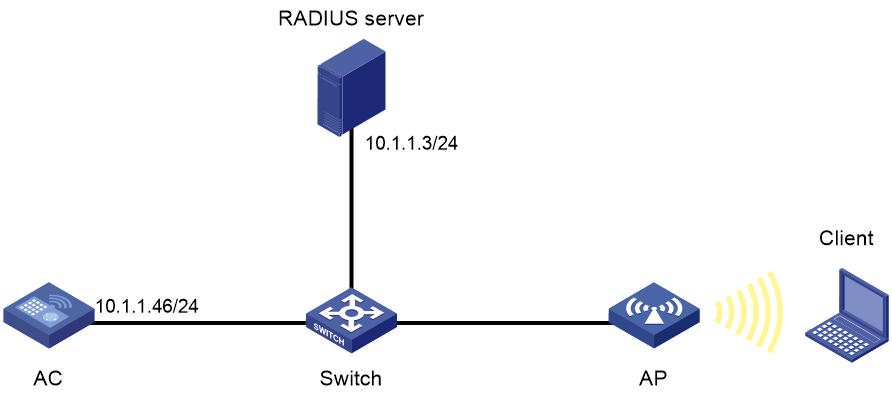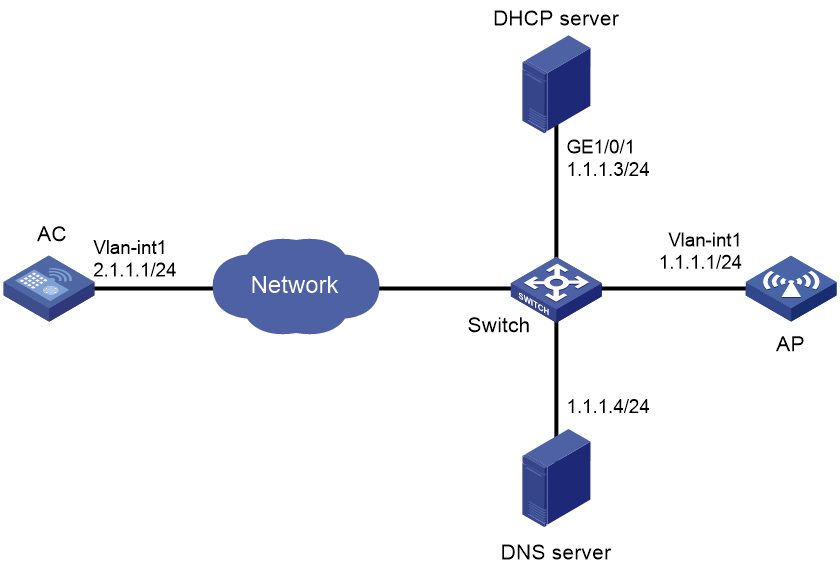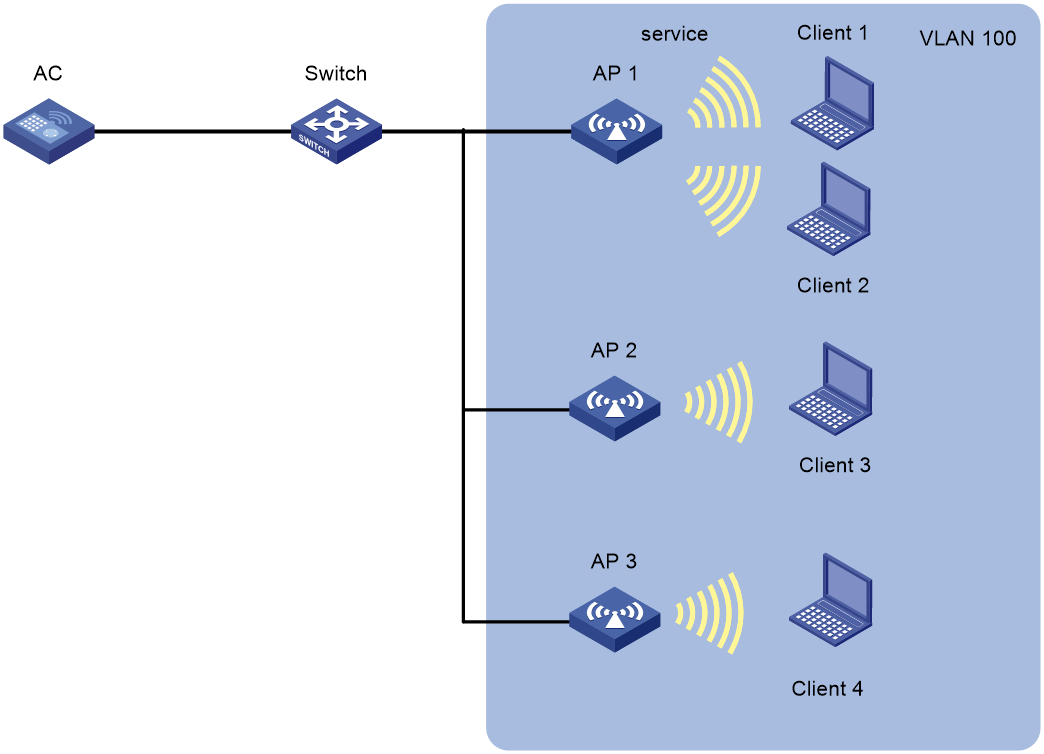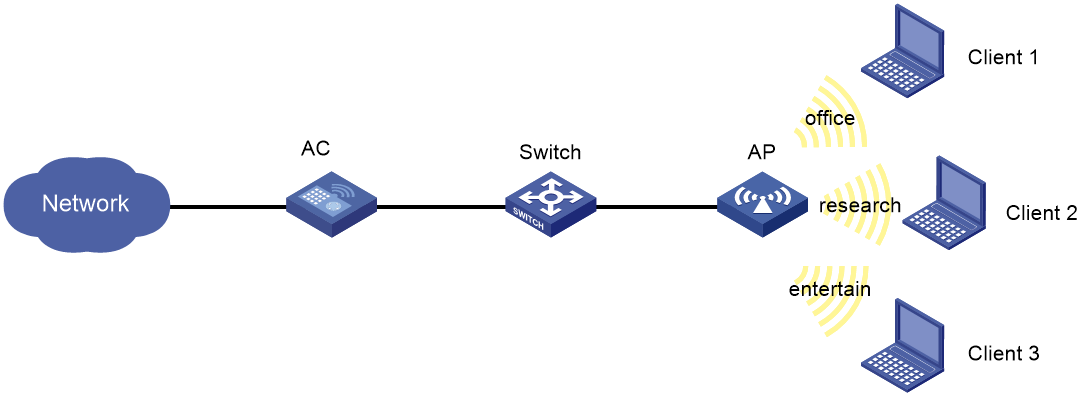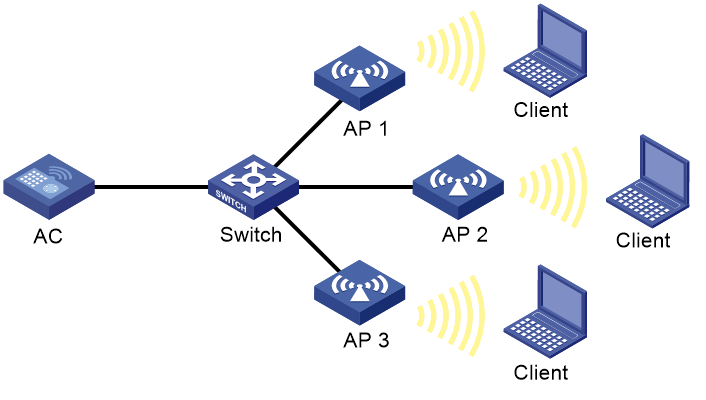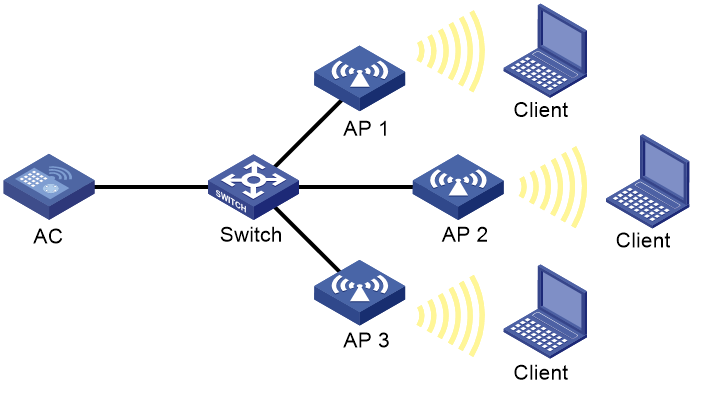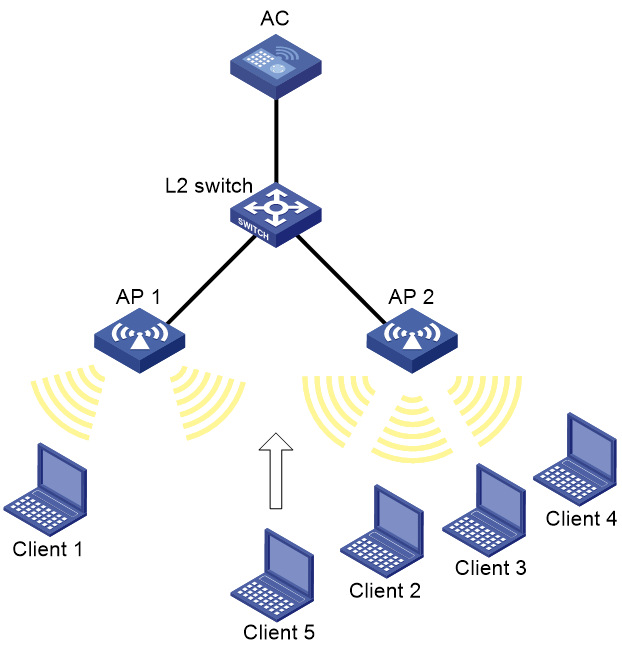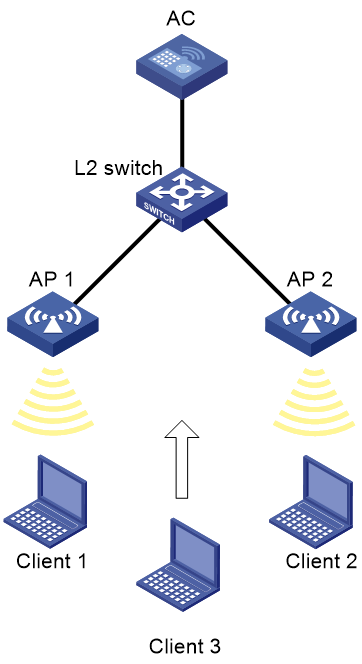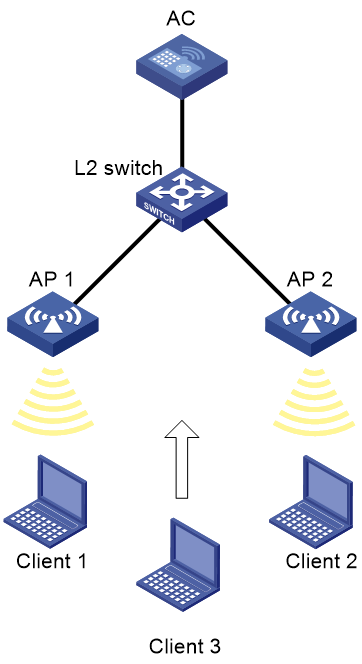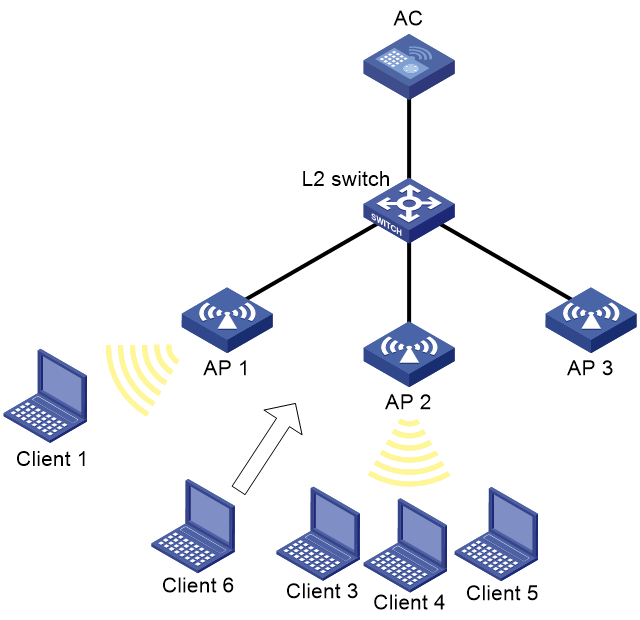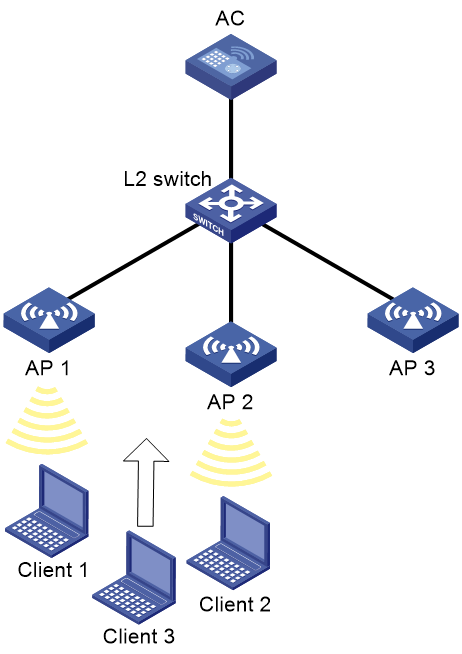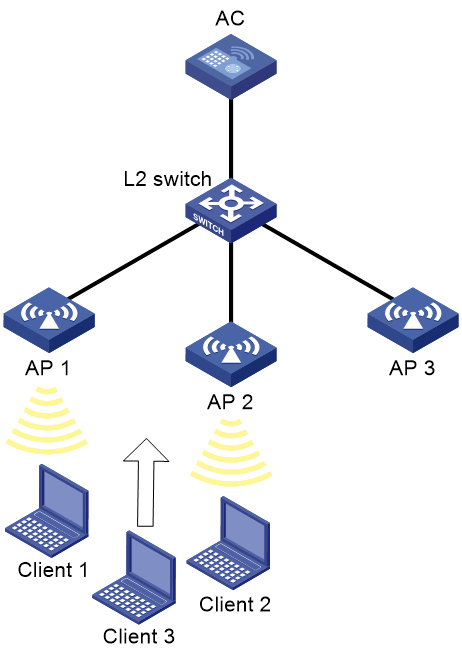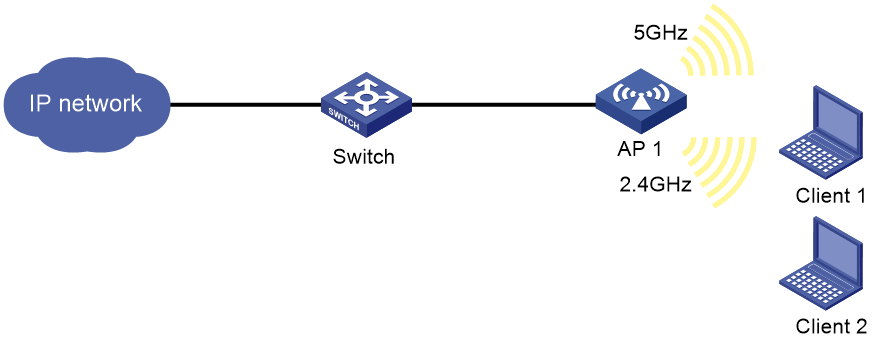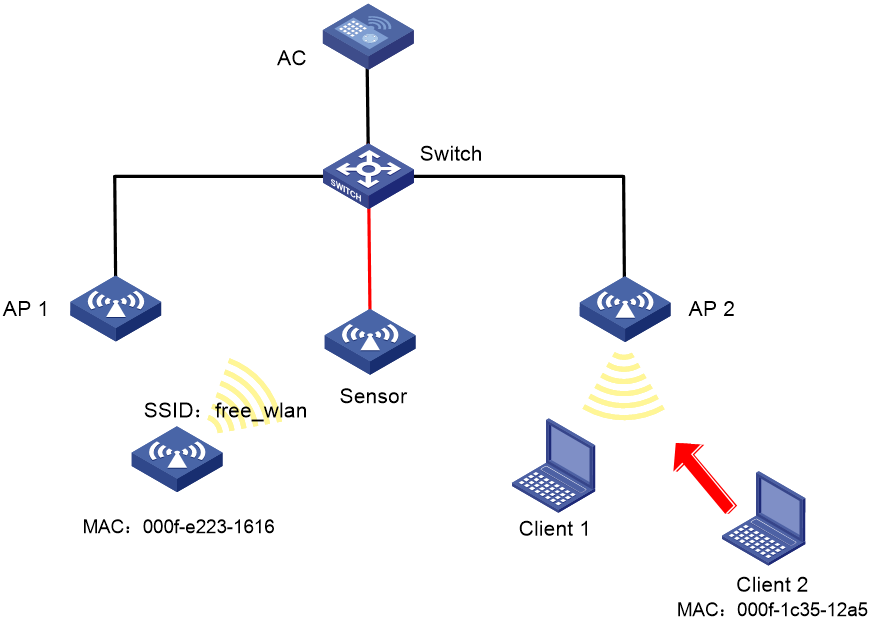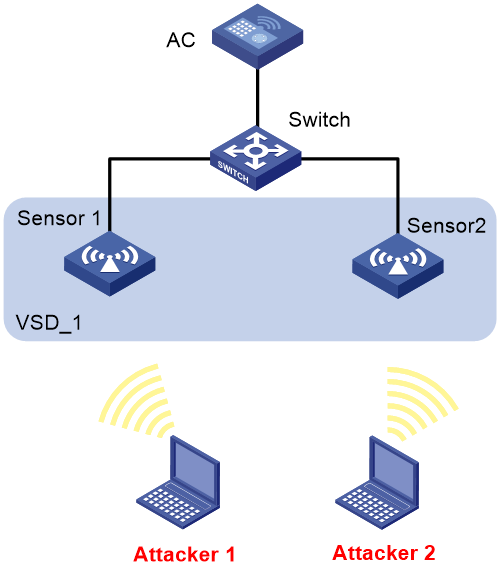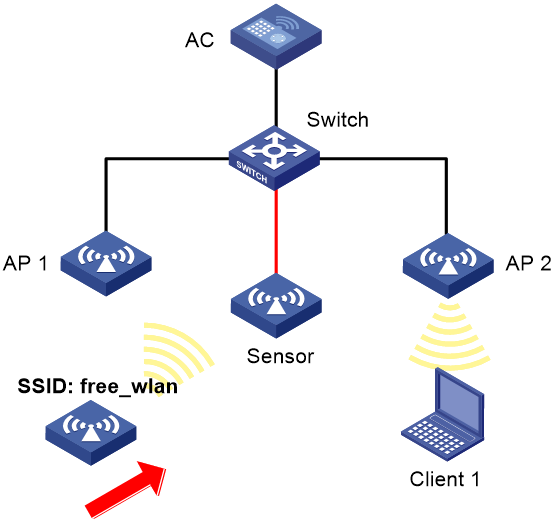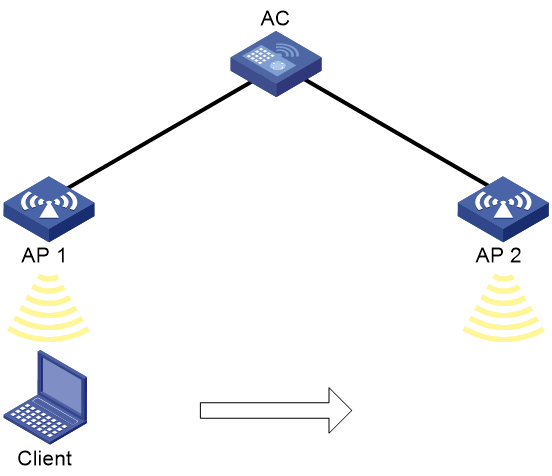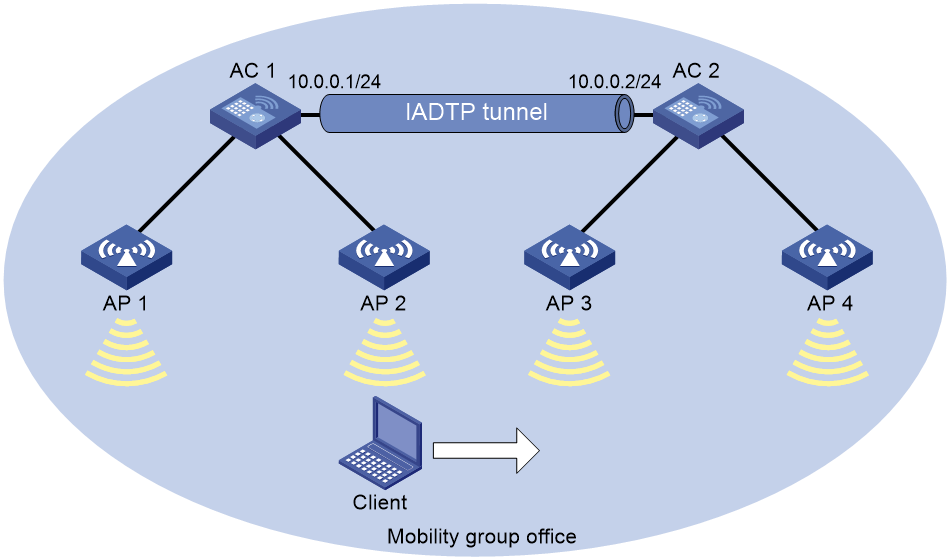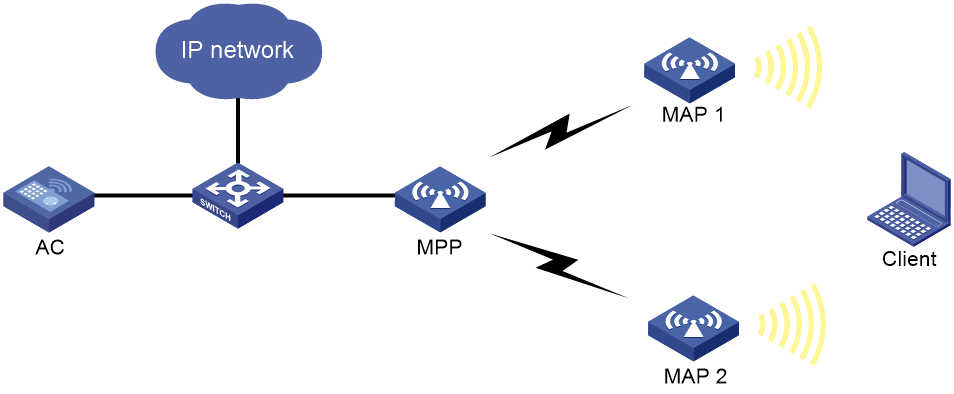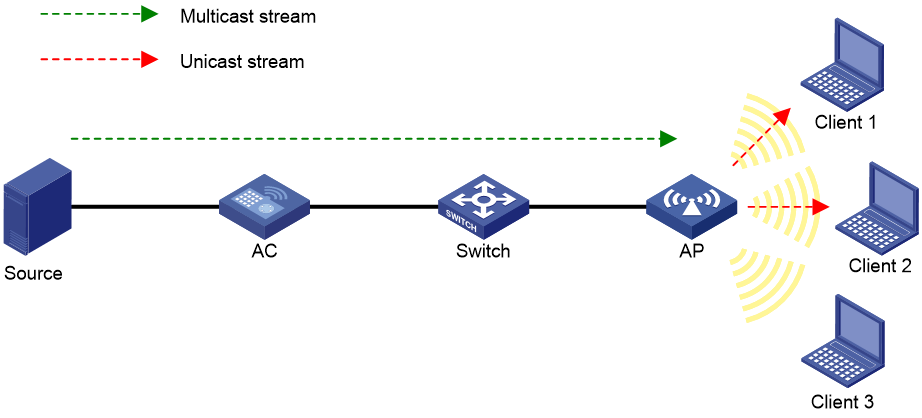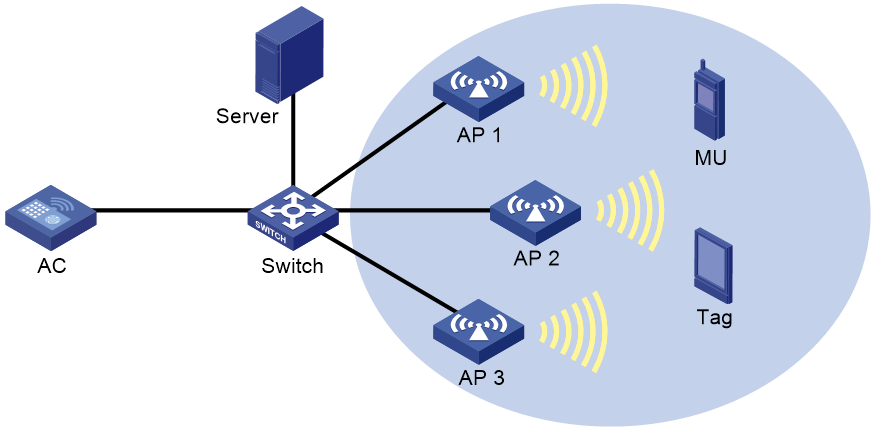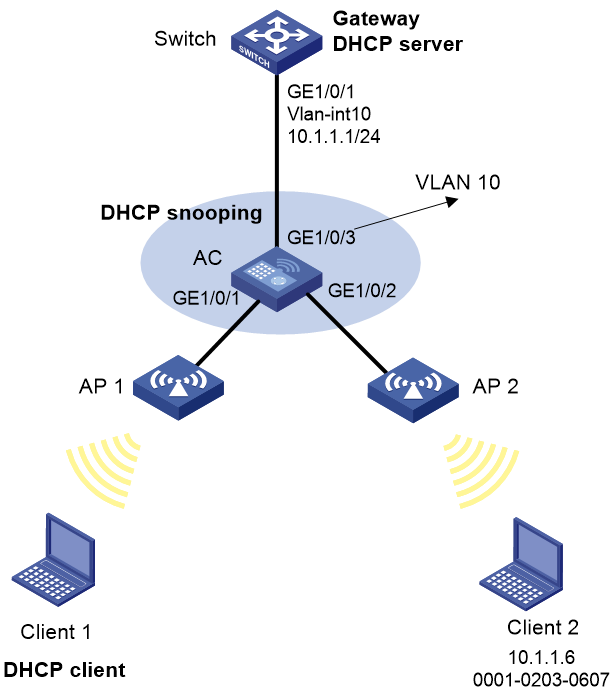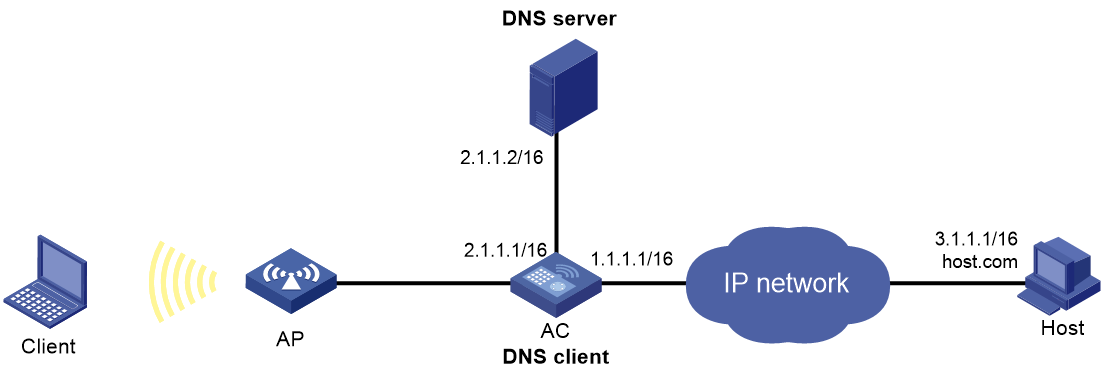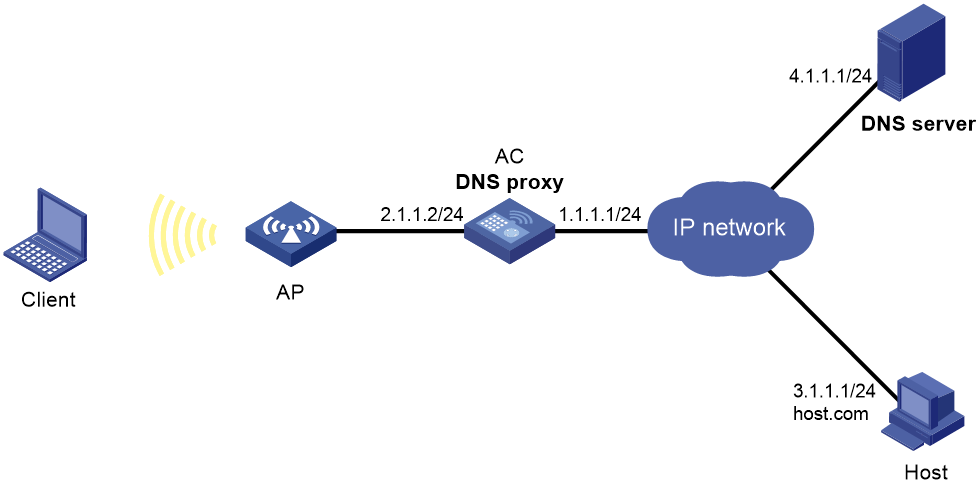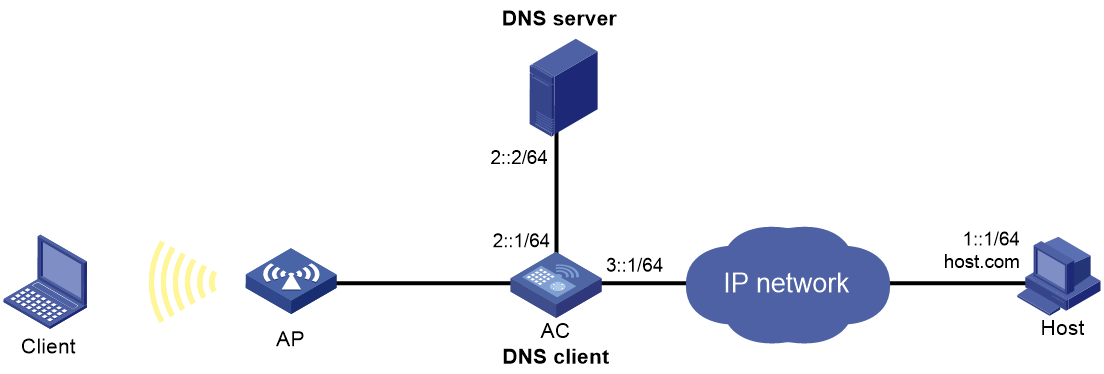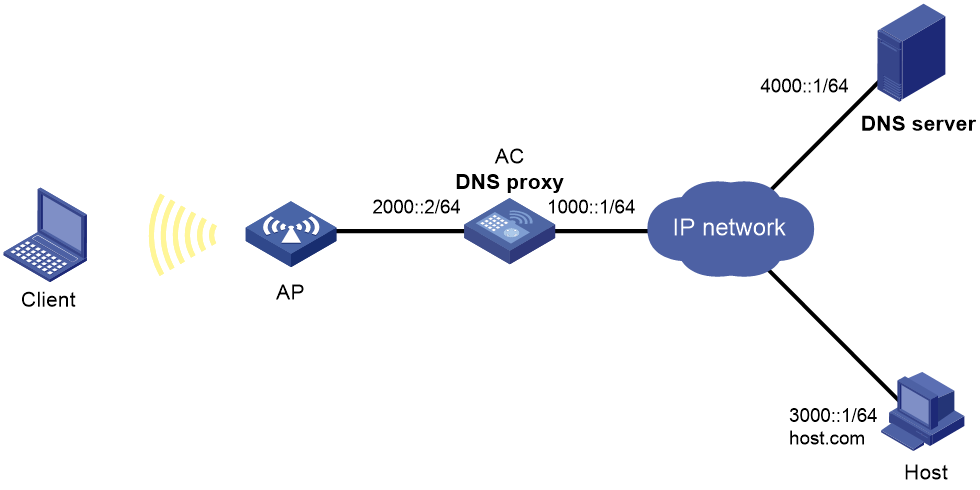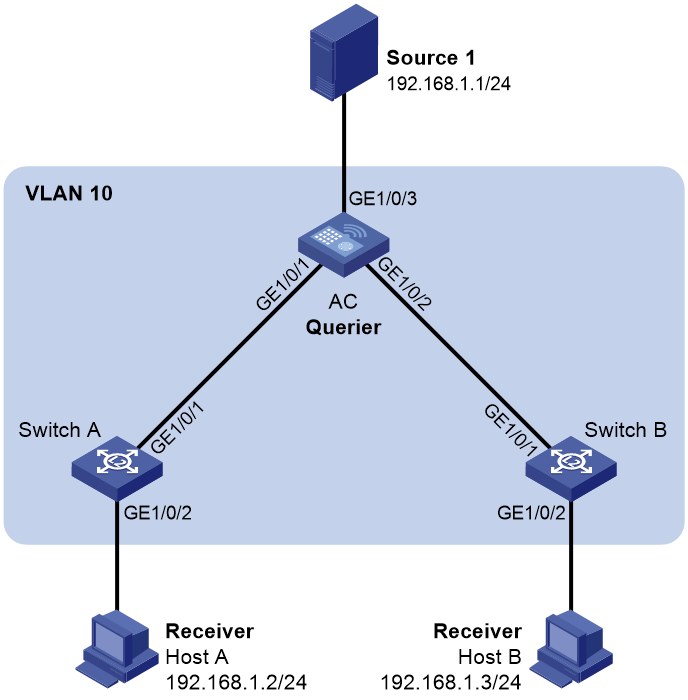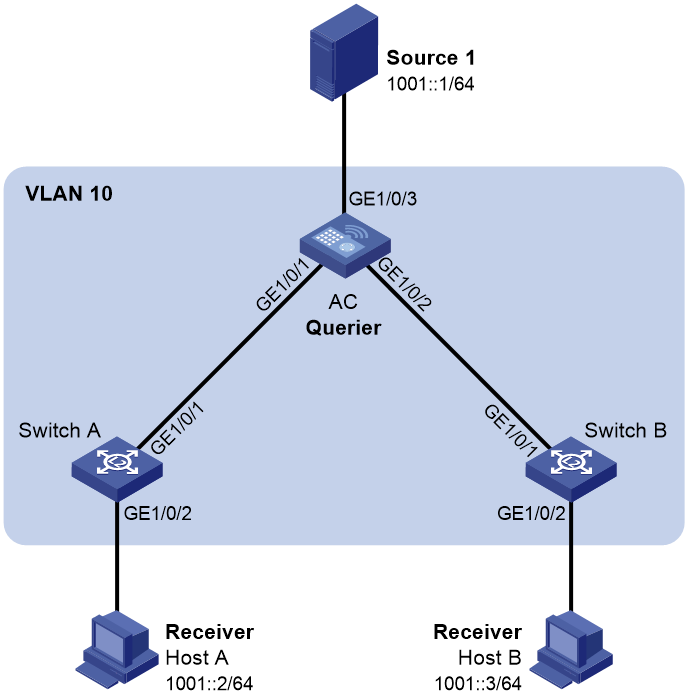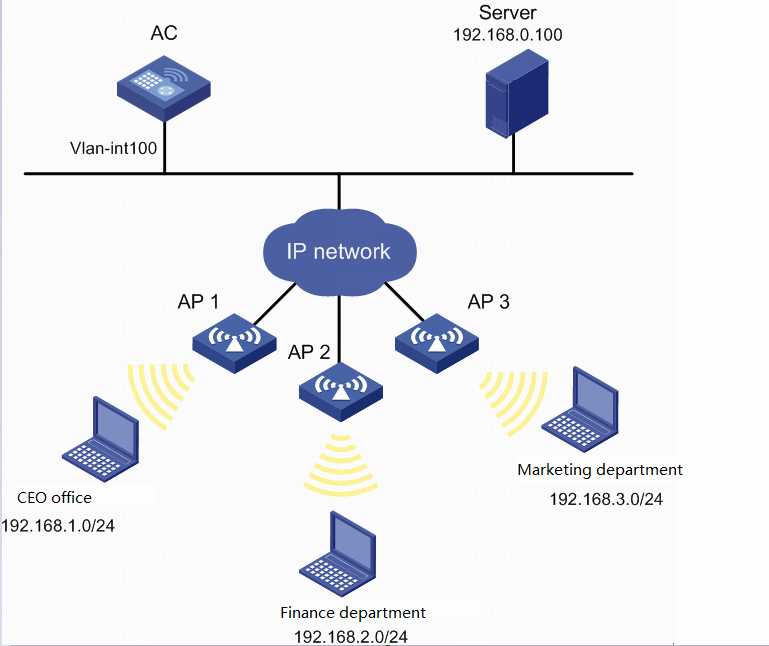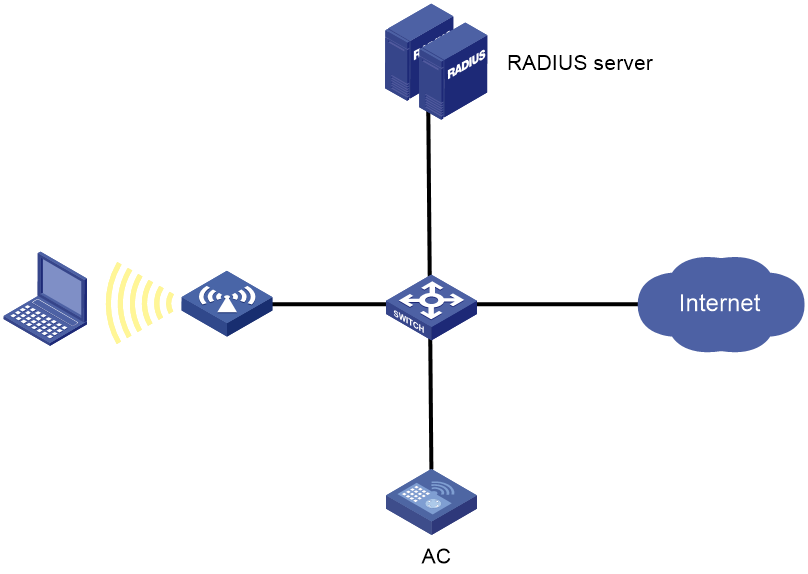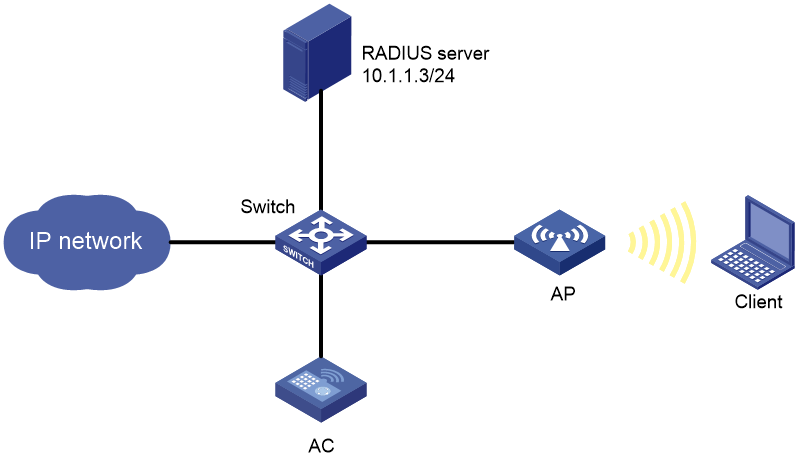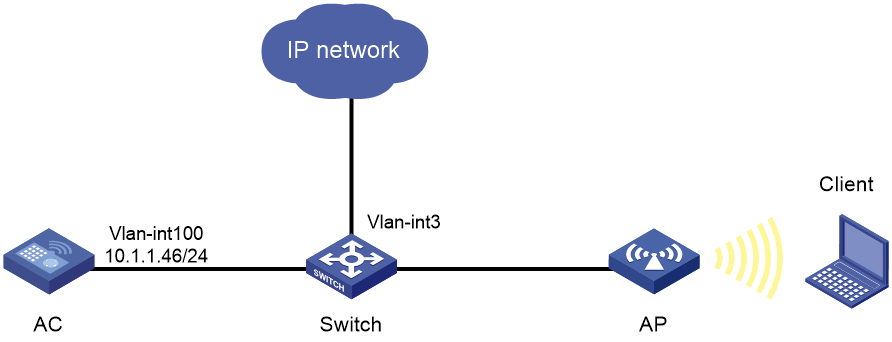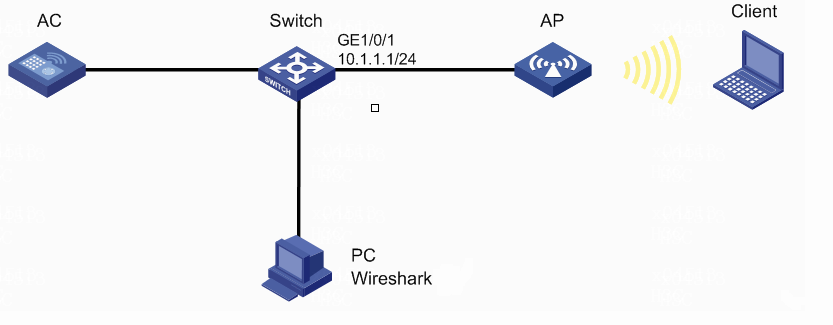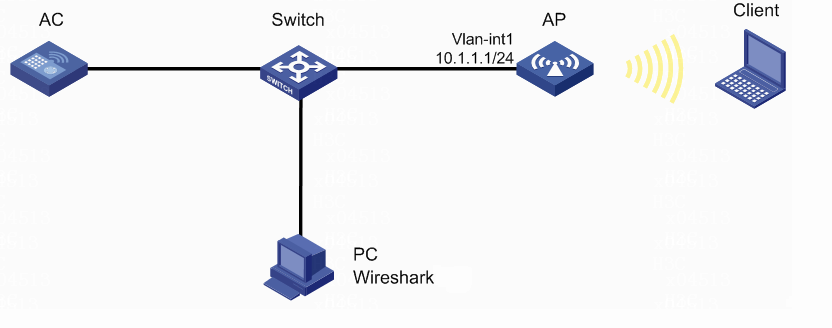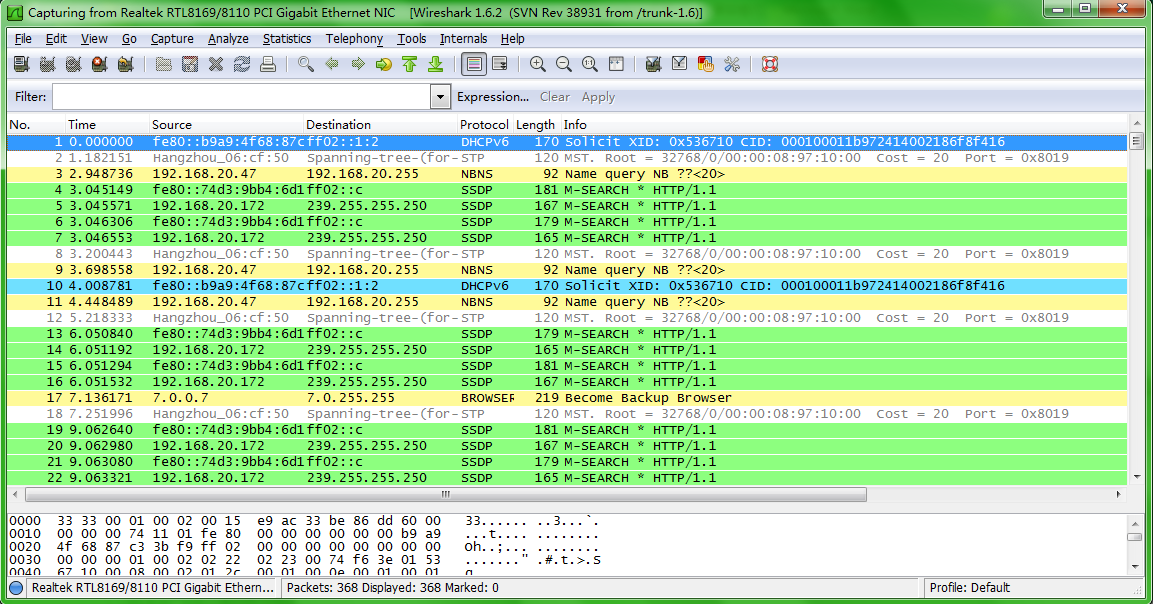- Table of Contents
- Related Documents
-
| Title | Size | Download |
|---|---|---|
| 05-Web configuration examples | 1.92 MB |
Contents
Wireless features configuration examples
Wireless service configuration examples
Shared key authentication configuration example
PSK authentication and bypass authentication configuration example
PSK authentication and MAC authentication configuration example
AP management configuration examples
CAPWAP tunnel establishment through DHCP configuration example
CAPWAP tunnel establishment through DNS configuration example
AP group configuration example
AP configuration file deployment configuration example
AP group configuration file deployment configuration example
Wireless QoS configuration examples
Client rate limiting configuration example
Bandwidth guarantee configuration example
Radio management configuration example
Radio management configuration example
Scheduled radio shutdown configuration example
WLAN RRM DFS configuration example
WLAN RRM TPC configuration example
WLAN RRM bandwidth adjustment configuration example
Session-mode load balancing configuration example
Traffic-mode load balancing configuration example
Bandwidth-mode load balancing configuration example
Session-mode load balancing configuration example for a load balancing group
Traffic-mode load balancing configuration example for a load balancing group
Bandwidth-mode load balancing configuration example for a load balancing group
Band navigation configuration example
Wireless security configuration examples
WIPS device classification and countermeasures configuration example
WIPS malformed packet and flood attack detection configuration example
Signature-based attack detection configuration example
Roaming configuration examples
Intra-AC roaming configuration example
Inter-AC roaming configuration example
Application configuration examples
WLAN mesh configuration example
Multicast optimization configuration example
Wireless locating configuration example
Network feature configuration examples
Interface configuration examples
Layer 2 static aggregation configuration example
Layer 2 dynamic aggregation configuration example
PPPoE client configuration example
DHCP snooping configuration example
Routing configuration examples
IPv4 static route configuration example
IPv6 static route configuration example
Outbound dynamic NAT configuration example
Outbound static NAT configuration example
Proxy ARP configuration example
ARP attack protection configuration example
IPv4 static DNS configuration example
IPv4 dynamic DNS configuration example
IPv4 DNS proxy configuration example
Static IPv6 address configuration example
IPv6 static DNS configuration example
IPv6 dynamic DNS configuration example
IPv6 DNS proxy configuration example
Multicast configuration examples
IGMP snooping configuration example
MLD snooping configuration example
Management protocol configuration examples
DHCP server configuration example
DHCP relay agent configuration example
Network security configuration examples
Access control configuration examples
ACL-based packet filter configuration example
Access authentication configuration examples
802.1X RADIUS authentication configuration example
802.1X local authentication configuration example
802.1X AKM configuration example
Direct IPv4 portal authentication configuration example
Guest management configuration examples
Guest management configuration example
System feature configuration examples
Device management configuration examples
Administrators configuration example
Packet capture configuration examples
Local packet capture configuration example
Remote packet capture configuration example
Wireless features configuration examples
Wireless service configuration examples
Shared key authentication configuration example
Network requirements
As shown in Figure 1, the switch functions as a DHCP server to assign IP addresses to the AP and client. Configure shared key authentication to enable the client to access the network by using the WEP key 12345.
Configuration procedure
1. Configure a wireless service:
a. From the navigation pane, select Wireless Configuration > Wireless Services > Wireless Services Configuration.
- Create a wireless service named service1.
- Set the SSID to service.
- Enable the wireless service.
2. Click Apply and Configure Advanced Settings, and then click the Authentication tab.
3. Configure static WEP authentication:
¡ Set the security type to static WEP.
¡ Set the key type to Passphrase.
¡ Select the WEP 40 cipher suite.
¡ Set the key to 12345.
4. Apply the wireless service.
5. Bind the wireless service service1 to the AP:
a. From the navigation pane, select Wireless Configuration > Wireless Services > Wireless Services Configuration.
b. Click the Edit icon in the Actions column for service1.
c. Click the Binding tab.
d. Select the 5 GHz radio of the AP and then click Apply.
Verifying the configuration
View details about the wireless service service1 to verify that the configuration is correct.
PSK authentication and bypass authentication configuration example
Network requirements
As shown in Figure 2, the switch functions as a DHCP server to assign IP addresses to the AP and client.
· Configure open system authentication and bypass authentication.
· Configure the client to use the preshared key 12345678 to access the network.
Configuration procedure
1. Configure a wireless service:
a. From the navigation pane, select Wireless Configuration > Wireless Services > Wireless Services Configuration.
b. Add a wireless service:
- Create a wireless service named service1.
- Set the SSID to service.
- Enable the wireless service.
2. Click Apply and Configure Advanced Settings, and then click the Authentication tab.
3. Configure static PSK authentication:
¡ Set the security type to static PSK.
¡ Set the security mode to WPA.
¡ Select the CCMP cipher suite.
¡ Set the key type to Passphrase and the key to 12345678.
4. Apply the wireless service.
5. Bind the wireless service service1 to the AP:
a. From the navigation pane, select Wireless Configuration > Wireless Services > Wireless Services Configuration.
b. Click the Edit icon in the Actions column for service1.
c. Click the Binding tab.
d. Select the 5 GHz radio of the AP and then click Apply.
Verifying the configuration
View details about the wireless service service1 to verify that the configuration is correct.
PSK authentication and MAC authentication configuration example
Network requirements
As shown in Figure 3, the switch functions as a DHCP server to assign IP addresses to the AP and client.
· Configure open system authentication and MAC authentication for clients.
· Configure the client to use the preshared key 12345678 to access the network.
Configuration procedure
1. On the RADIUS server, configure the client's MAC address as the username and password used for authentication. The MAC address cannot contain hyphens and upper case letters.
2. Configure the RADIUS server correctly to provide authentication, authorization, and accounting functions.
3. Configure RADIUS and an authentication domain.
4. Configure a wireless service:
a. From the navigation pane, select Wireless Configuration > Wireless Services > Wireless Services Configuration.
b. Add a wireless service:
- Create a wireless service named service1.
- Set the SSID to service.
- Enable the wireless service.
5. Click Apply and Configure Advanced Settings, and then click the Authentication tab.
6. Configure static PSK authentication and MAC authentication:
¡ Set the security type to static PSK and select MAC authentication.
¡ Set the security mode to WPA.
¡ Select the CCMP cipher suite.
¡ Set the key type to Passphrase and the key to 12345678.
¡ Set the domain name to dom1.
7. Apply the wireless service.
8. Bind the wireless service service1 to the AP:
a. From the navigation pane, select Wireless Configuration > Wireless Services > Wireless Services Configuration.
b. Click the Edit icon in the Actions column for service 1.
c. Click the Binding tab.
d. Select the 5 GHz radio of the AP and then click Apply.
Verifying the configuration
View details about the wireless service service1 to verify that the configuration is correct.
AP management configuration examples
CAPWAP tunnel establishment through DHCP configuration example
Network requirements
As shown in Figure 4, configure the AP to obtain its IP address and the AC's IP address from the DHCP server (the AC) through DHCP Option 43. The AP uses the IP address of the AC to establish a CAPWAP tunnel with the AC.
Configuration procedure
1. Set the AC IP address:
a. From the navigation pane, select Network Configuration > Network Links > VLAN.
b. Click the Edit icon in the Actions column for VLAN-interface 1.
c. Set the IP address to 1.1.1.1/24.
2. Configure DHCP:
a. From the navigation pane, select Network Configuration > Management Protocols > DHCP.
b. Enable the DHCP service.
c. Access the DHCP configuration page to select DHCP server from the DHCP service list for VLAN-interface 1.
d. Access the address pool configuration page. You are placed on the Assigned Address tab.
e. Click Add Address Pool and then perform the following tasks:
- Create an address pool named pool1.
- Specify subnet 1.1.1.0/24 for dynamic IP address assignment.
f. Click the DHCP Options tab.
g. Perform the following tasks:
- Set the gateway address to 1.1.1.1.
- Configure DHCP Option 43 to specify the AC's IP address in the hexadecimal format. The option content is 800700000101010101 in this example.
3. Configure the AP:
a. From the navigation pane, select Wireless Configuration > AP Management > AP.
b. Add and configure AP 1:
- Set the AP name to AP1.
- Set the AP model and serial ID.
Verifying the configuration
# Access the Wireless Configuration > AP Management > AP page to verify that AP 1 has come online.
# Access the AP details page to verify the following information:
· The AP has obtained an IP address.
· The AC IP address is 1.1.1.1/24.
· The AC discovery type is DHCP.
CAPWAP tunnel establishment through DNS configuration example
Network requirements
As shown in Figure 5, configure the AP to obtain the IP address of the AC through DNS to establish a CAPWAP tunnel with the AC.
Configuration procedure
1. On the DHCP server, specify subnet 1.1.1.0/24 for IP address assignment, set the domain name suffix of the AC to abc, and specify the DNS server address as 1.1.1.4/24. (Details not shown.)
2. On the DNS server, configure a mapping between domain name host.abc and IP address 1.1.1.1/24. (Details not shown.)
3. Set the AC's IP address:
a. From the navigation pane, select Network Configuration > Network Links > VLAN.
b. Click the Edit icon in the Actions column for VLAN-interface 1.
c. Set the IP address to 2.1.1.1/24.
4. Configure the AP:
a. From the navigation pane, select Wireless Configuration > AP Management > AP.
b. Add and configure AP 1:
- Set the AP name to AP1.
- Set the AP model and serial ID.
Verifying the configuration
# Access the Wireless Configuration > AP Management > AP page to verify that AP 1 has come online.
# Access the AP details page to verify the following information:
· The AP has obtained an IP address.
· The AC's IP address is 1.1.1.1/24.
· The AC discovery type is DNS.
Auto AP configuration example
Network requirements
As shown in Figure 6, enable the auto AP feature on the AC. The AP obtains the AC's IP address through DHCP Option 43 and establishes a CAPWAP tunnel with the AC.
Configuration procedure
1. Set the AC IP address:
a. From the navigation pane, select Network Configuration > Network Links > VLAN.
b. Click the Edit icon in the Actions column for VLAN-interface 1.
c. Set the IP address to 1.1.1.1/24.
2. Configure DHCP:
a. From the navigation pane, select Network Configuration > Management Protocols > DHCP.
b. Enable the DHCP service.
c. Access the DHCP configuration page to select DHCP server from the DHCP service list for VLAN-interface 1.
d. Access the address pool configuration page. You are placed on the Assigned Address tab.
e. Click Add Address Pool and then perform the following tasks:
- Create an address pool named pool1.
- Specify subnet 1.1.1.0/24 for dynamic IP address assignment.
f. Click the DHCP Options tab.
g. Perform the following tasks:
- Set the gateway address to 1.1.1.1.
- Configure DHCP Option 43 to specify the AC's IP address in the hexadecimal format. The option content is 800700000101010101 in this example.
3. Configure the AP:
a. From the navigation pane, select Wireless Configuration > AP Management > AP Global Settings.
b. Enable the auto AP feature.
Verifying the configuration
# Access the Wireless Configuration > AP Management > AP page to verify that AP 1 has come online as an auto AP.
AP group configuration example
Network requirements
As shown in Figure 7, configure AP groups and add AP 1 to the AP group group1, and AP 2, AP 3, and AP 4 to the AP group group2.
Configuration procedure
1. Configure APs to obtain their IP addresses and the AC's IP address from the DHCP server. (Details not shown.)
2. Configure the AP groups:
a. From the navigation pane, select Wireless Configuration > AP Management > AP Groups.
b. Add AP group group1, and create an AP name grouping rule to add AP ap1 to the AP group.
c. Add AP group group2, and create an AP name grouping rule to add APs ap2, ap3, and ap4 to the AP group.
Verifying the configuration
# Access the AP groups page to verify the following information:
· The AP ap1 is in the AP list of the AP group group1.
· The APs ap 2, ap 3, and ap 4 are in the AP list of the AP group group2.
AP configuration file deployment configuration example
Network requirements
As shown in Figure 8, the AP connects to the AC through the switch. Configure the AC to deploy a configuration file to the AP to isolate Client 1 and Client 2.
Configuration procedure
1. Configure the AP to obtain its IP address and the AC's IP address through DHCP, and configure wireless services and radio settings. (Details not shown.)
2. Edit the AP configuration file, add user isolation commands to the file, and name the file apcfg.txt.
3. From the navigation pane, select Wireless Configuration > AP Management > AP.
4. Click Edit for the target AP, select map file apcfg.txt for the AP, and then click OK.
Verifying the configuration
Verify that Client 1 and Client 2 can access the Internet, but cannot reach each other.
AP group configuration file deployment configuration example
Network requirements
As shown in Figure 9, the APs connect to the AC through the switch. Add the APs to the same AP group and configure the AC to deploy a configuration file to the AP group to isolate clients associated with the same AP.
Configuration procedure
1. Configure the APs to obtain their IP addresses and the AC's IP address through DHCP, add the APs to the same AP group, and configure wireless services and radio settings. (Details not shown.)
2. Edit the AP group configuration file, add user isolation configuration commands to the file, and name the file apcfg.txt.
3. From the navigation pane, select Wireless Configuration > AP Management > AP Groups.
4. Click Edit for the target AP group, select map file apcfg.txt for the AP group, and then click OK.
Verifying the configuration
Verify that Client 1 and Client 2 can access the Internet, but cannot reach each other.
Wireless QoS configuration examples
Client rate limiting configuration example
Network requirements
As shown in Figure 10, the AC is in the same network as the AP. Perform the following tasks on the AC:
· Configure static mode client rate limiting to limit the rate of incoming client traffic.
· Configure dynamic mode client rate limiting to limit the rate of outgoing client traffic.
Configuration procedure
1. Configure a wireless service:
a. From the navigation pane, select Wireless Configuration > Wireless Services > Wireless Services Configuration.
b. Add a wireless service:
- Create a wireless service named service.
- Set the SSID to service.
- Enable the wireless service.
2. Configure the AP:
a. From the navigation pane, select Wireless Configuration > AP Management > AP.
b. Add and configure AP 1:
- Set the AP name to AP1, configure the AP model and serial number, and then apply the configuration.
- Click the Edit icon in the Actions column for AP 1.
- Click the WLAN Service Settings tab, and bind the wireless service service to radio 1 of AP 1.
3. Configure client rate limiting:
a. From the navigation pane, select Wireless Configuration > Wireless QoS > Client Rate Limit.
b. Click the More icon in the service based configuration area.
c. Select the service name service, and click the edit icon for the wireless service service.
d. On the edit page, perform the following tasks:
- Set the limit mode to static mode for inbound traffic.
- Set the per-client limit rate to 8000 for inbound traffic.
- Set the limit mode to dynamic mode for outbound traffic.
- Set the per-client limit rate to 4000 for outbound traffic.
4. Enable radio 1 for AP 1:
a. From the navigation pane, select Wireless Configuration > Radio Management > Radio Configuration.
b. Click the details icon in the all AP radio configuration area.
c. Select the combination of AP 1 and radio 1, and click the corresponding edit icon.
d. On the edit page, enable radio 1.
Verifying the configuration
Verify that the download rate and upload rate of each client do not exceed 8 Mbps and 4 Mbps, respectively.
Bandwidth guarantee configuration example
Network requirements
As shown in Figure 11, Clients 1, 2, and 3 access the network through the SSIDs research, office, and entertain, respectively.
For the network to operate correctly, guarantee 20% of the bandwidth for the SSID office, 80% for research, and none for entertain.
Configuration procedure
1. Configure wireless services:
a. From the navigation tree, select Wireless Configuration > Wireless Services > Wireless Services Configuration.
b. Add wireless services:
- Create wireless services named office, research, and entertain.
- Set their SSID to office, research, and entertain, respectively.
- Enable the wireless services.
2. Configure the AP:
a. From the navigation tree, select Wireless Configuration > AP Management > AP.
b. Add and configure AP 1:
- Set the AP name to AP1, and configure the AP model and serial number.
- Click the edit icon in the operation column for AP 1.
- Click the wireless service setting tab, and bind the wireless services office, research, and entertain to radio 1 of AP 1.
3. Configure bandwidth guaranteeing:
a. From the navigation tree, select Wireless Configuration > Wireless QoS > Bandwidth Guarantee.
b. Click the more icon in the AP configuration area.
c. Select the combination of AP 1 and radio 1, and click the edit icon.
d. On the edit page, perform the following tasks:
- Enable bandwidth guaranteeing.
- Set the guaranteed bandwidth percentage to 20% for the wireless service office.
- Set the guaranteed bandwidth percentage to 80% for the wireless service research.
4. Enable radio 1 for AP 1:
a. From the navigation tree, select Wireless Configuration > Radio Management > Radio Configuration.
b. Click the details icon in the all AP radio configuration area.
c. Select the combination of AP 1 and radio 1, and click the corresponding edit icon.
d. On the edit page, enable radio 1.
Verifying the configuration
# View details about AP configuration to verify that the effective bandwidth percentage for each SSID is not greater than the guaranteed bandwidth percentage.
Radio management configuration example
Radio management configuration example
Network requirements
As shown in Figure 12, perform the following tasks to configure the 5 GHz radio of the AP:
· Set the radio type, working channel, and maximum transmit power to 802.11ac, 48, and 19 dBm, respectively.
· Set the maximum mandatory NSS, maximum supported NSS, multicast NSS, and VHT-MCS index to 2, 3, 2, and 5, respectively.
· Enable the A-MSDU and A-MPDU aggregation methods to improve network throughput.
Configuration procedure
1. From the navigation pane, select Wireless Configuration > Radio Management > Radio Configuration.
2. Access the details page for all AP radio configurations.
3. Click the Edit icon in the Actions column for the 5 GHz radio of the AP. You are placed on the Basic tab.
4. Perform the following tasks in the basic configuration area:
a. Enable the radio.
b. Set the radio type to 802.11ac (5GHz).
c. Set the channel to 48.
d. Set the maximum transmit power to 19 dBm.
5. Perform the following tasks in the rates configuration area:
a. Set the maximum mandatory NSS to 2.
b. Set the maximum supported NSS to 3.
c. Set the multicast NSS to 2.
d. Set the VHT-MCS index to 5.
6. Perform the following tasks in the 802.11n/802.11ac configuration area:
a. Enable the A-MSDU aggregation method.
b. Enable the A-MPDU aggregation method.
7. Apply the configuration.
Verifying the configuration
# Access the Wireless Configuration > Radio Management > Radio Configuration page to verify that the configuration is correct.
Scheduled radio shutdown configuration example
Network requirements
As shown in Figure 13, configure scheduled radio shutdown to automatically disable radio 1 on the AP at the specified time.
Configuration procedure
1. Configure a wireless service:
a. From the navigation pane, select Wireless Configuration > Wireless Services > Wireless Services Configuration.
b. Add a wireless service:
- Create a wireless service named service.
- Set the SSID to service.
- Enable the wireless service.
2. Configure the AP:
a. From the navigation pane, select Wireless Configuration > AP Management > AP.
b. Add and configure AP 1:
- Set the AP name to AP1, configure the AP model and serial number, and then apply the configuration.
- Click the Edit icon in the Actions column for AP 1.
- Click the WLAN Service Settings tab, and bind the wireless service service to radio 1 of AP 1.
3. Configure scheduled radio shutdown:
a. From the navigation pane, select Wireless Configuration > Radio Management > Radio Configuration.
b. Click the More icon in the Radios configured with scheduled shutdown area.
c. On the Radios configured with scheduled shutdown tab, select radio 1 of AP 1.
d. Set the scheduled radio shutdown time ranges to 00:00 to 08:00 every Monday to Friday, 22:00 to 24:00 every Monday to Friday, and 00:00 to 24:00 every Saturday to Sunday.
Verifying the configuration
1. From the navigation pane, select Wireless Configuration > Radio Management > Radio Configuration.
2. In the Radios configured with scheduled shutdown area, verify that the scheduled radio shutdown task is valid and the radio is disabled when the system time of the device is within the specified time ranges.
3. Verify that the radio is enabled when the system time of the device is not in the specified time ranges.
WLAN RRM DFS configuration example
Network requirements
As shown in Figure 14, configure auto-DFS to adjust channels for the APs when a channel adjustment trigger condition is met.
Configuration procedure
1. Specify a working channel for each AP:
a. From the navigation tree, select Wireless Configuration > Radio Management > Radio Configuration.
b. Access the details page for radio configuration and set the working channel to Auto unlock for AP 1, AP 2, and AP 3.
2. Configure auto-DFS:
a. From the navigation tree, select Wireless Configuration > Radio Management > RRM.
b. Enable auto-DFS for AP 1, AP 2, AP 3, and AP 4.
Verifying the configuration
# On the Monitoring > RF Monitoring > RRM page, verify that the working channels for the APs change when a channel adjustment trigger condition is met and the calibration interval is reached.
WLAN RRM TPC configuration example
Network requirements
As shown in Figure 15, configure auto-TPC and set the neighbor number threshold as 3 to enable the AC to perform auto-TPC when AP 4 joins.
Configuration procedure
1. Disable power lock for the APs:
a. From the navigation tree, select Wireless Configuration > Radio Management > Radio Configuration.
b. Access the details page for radio configuration to disable power lock for AP 1, AP 2, AP 3, and AP 4.
2. Configure auto-TPC:
a. From the navigation tree, select Wireless Configuration > Radio Management > RRM.
b. Enable auto-TPC for AP 1, AP 2, AP 3, and AP 4.
Verifying the configuration
# On the Monitoring > RF Monitoring > RRM page, verify that the power values for the APs change when the power adjustment threshold and the calibration interval are reached.
WLAN RRM bandwidth adjustment configuration example
Network requirements
As shown in Figure 16, configure automatic bandwidth adjustment to enable the AC to automatically adjust the bandwidth for the radios when the trigger condition is met.
Configuration procedure
1. From the navigation tree, select Wireless Configuration > Radio Management > RRM.
2. Enable global bandwidth adjustment.
3. Click the more icon in the bandwidth adjustment area to set the bandwidth adjustment interval to 10 minutes.
Verifying the configuration
# From the navigation tree, select Wireless Configuration > Radio Management > RRM, and then access the RRM history information page to verify that the bandwidth value for the radio changes when the bandwidth adjustment threshold and the calibration interval are reached.
Session-mode load balancing configuration example
Network requirements
As shown in Figure 17, AP 1 and AP 2 are managed by the AC and the clients can discover the APs.
Configure the AC to perform session-mode load balancing on AP 1 and AP 2 when the following conditions are met:
· The number of sessions on one AP reaches 3.
· The session gap between the APs reaches 2.
Configuration procedure
1. Configure a wireless service:
a. From the navigation pane, select Wireless Configuration > Wireless Services > Wireless Services Configuration.
b. Add a wireless service:
- Create a wireless service named service.
- Set the SSID to session-balance.
- Enable the wireless service.
2. Configure the APs:
a. From the navigation pane, select Wireless Configuration > AP Management > AP.
b. Add and configure AP 1:
- Set the AP name to AP1, configure the AP model and serial number, and then apply the configuration.
- Click the Edit icon in the Actions column for AP 1.
- Click the WLAN Service Settings tab, and bind the wireless service service to radio 2 of AP 1.
c. Add and configure AP 2 in the same way AP 1 is added and configured.
3. Configure load balancing:
a. From the navigation pane, select Wireless Configuration > Radio Management > Load Balancing.
b. Access the details page for global configuration to perform the following tasks:
- Enable load balancing.
- Select Session Mode.
- Set the session threshold to 3 and the session gap to 2.
Verifying the configuration
# Connect clients 2, 3, and 4 to radio 2 of AP 2, connect client 1 to radio 2 of AP 1, and then try to connect client 5 to AP 2.
# Verify that AP 2 rejects client 5 and client 5 can access the WLAN only from AP 1.
# On the Monitoring > Clients > Client Info page, verify that AP 1 and AP 2 are load balanced.
Traffic-mode load balancing configuration example
Network requirements
As shown in Figure 18, AP 1 and AP 2 are managed by the AC and the clients can discover the APs. The maximum bandwidth for each AP is 250 Mbps. Configure 2.4 GHz radios on the APs to operate in 802.11gn mode.
Configure the AC to perform traffic-mode load balancing on AP 1 and AP 2 when the following conditions are met:
· The traffic on one AP reaches 50 Mbps (20% of the maximum bandwidth).
· The traffic gap between the APs reaches 25 Mbps (10% of the maximum bandwidth).
Configuration procedure
1. Configure a wireless service:
a. From the navigation pane, select Wireless Configuration > Wireless Services > Wireless Services Configuration.
b. Add a wireless service:
- Create a wireless service named service.
- Set the SSID to traffic-balance.
- Enable the wireless service.
2. Configure the APs:
a. From the navigation pane, select Wireless Configuration > AP Management > AP.
b. Add and configure AP 1:
- Set the AP name to AP1, configure the AP model and serial number, and then apply the configuration.
- Click the Edit icon in the Actions column for AP 1.
- Click the WLAN Service Settings tab, and bind the wireless service service to radio 2 of AP 1.
c. Add and configure AP 2 in the same way AP 1 is added and configured.
3. Configure load balancing:
a. From the navigation pane, select Wireless Configuration > Radio Management > Load Balancing.
b. Access the details page for global configuration to perform the following tasks:
- Enable load balancing.
- Select Traffic Mode.
- Set the traffic threshold to 20 and the traffic gap to 10.
Verifying the configuration
# Verify that the AC performs session-mode load balancing for AP 1 and AP 2 when the following conditions are met:
· The traffic of radio 2 on AP 1 reaches 50 Mbps.
· The traffic gap between the APs reaches 25 Mbps.
# On the Monitoring > Clients > Client Info page, verify that AP 1 and AP 2 are load balanced.
Bandwidth-mode load balancing configuration example
Network requirements
As shown in Figure 19, AP 1 and AP 2 are managed by the AC and the clients can discover the APs.
Configure the AC to perform bandwidth-mode load balancing on AP 1 and AP 2 when the following conditions are met:
· The bandwidth of one AP reaches 12 Mbps.
· The bandwidth gap between the APs reaches 3 Mbps.
Configuration procedure
1. Configure a wireless service:
a. From the navigation pane, select Wireless Configuration > Wireless Services > Wireless Services Configuration.
b. Add a wireless service:
- Create a wireless service named service.
- Set the SSID to bandwidth-balance.
- Enable the wireless service.
2. Configure the APs:
a. From the navigation pane, select Wireless Configuration > AP Management > AP.
b. Add and configure AP 1:
- Set the AP name to AP1, configure the AP model and serial number, and then apply the configuration.
- Click the Edit icon in the Actions column for AP 1.
- Click the WLAN Service Settings tab, and bind the wireless service service to radio 2 of AP 1.
c. Add and configure AP 2 in the same way AP 1 is added and configured.
3. Configure load balancing:
a. From the navigation pane, select Wireless Configuration > Radio Management > Load Balancing.
b. Access the details page for global configuration to perform the following tasks:
- Enable load balancing.
- Select Bandwidth Mode.
- Set the bandwidth threshold to 12 and the bandwidth gap to 3.
Verifying the configuration
# Verify that the AC performs bandwidth-mode load balancing for AP 1 and AP 2 when the following conditions are met:
· The bandwidth of radio 2 on AP 1 reaches 12 Mbps.
· The bandwidth gap between the APs reaches 3 Mbps.
# On the Monitoring > Clients > Client Info page, verify that AP 1 and AP 2 are load balanced.
Session-mode load balancing configuration example for a load balancing group
Network requirements
As shown in Figure 20, AP 1, AP 2, and AP 3 are managed by the AC and the clients can discover the APs.
Configure the AC to perform session-mode load balancing on radio 2 of AP 1 and radio 2 of AP 2 when the following conditions are met:
· The number of sessions on one radio reaches 3.
· The session gap between the radios reaches 2.
Configuration procedure
1. Configure a wireless service:
a. From the navigation pane, select Wireless Configuration > Wireless Services > Wireless Services Configuration.
b. Add a wireless service:
- Create a wireless service named service.
- Set the SSID to session-balance.
- Enable the wireless service.
2. Configure the APs:
a. From the navigation pane, select Wireless Configuration > AP Management > AP.
b. Add and configure AP 1:
- Set the AP name to AP1, configure the AP model and serial number, and then apply the configuration.
- Click the Edit icon in the Actions column for AP 1.
- Click the WLAN Service Settings tab, and bind the wireless service service to radio 2 of AP 1.
c. Add and configure AP 2 and AP 3 in the same way AP 1 is added and configured.
3. Configure load balancing:
a. From the navigation pane, select Wireless Configuration > Radio Management > Load Balancing.
b. Access the details page for global configuration to perform the following tasks:
- Enable load balancing.
- Select Session Mode.
- Set the session threshold to 3 and the session gap to 2.
c. Access the details page for load balancing group configuration to perform the following tasks:
- Create a load balancing group.
- Bind radio 2 of AP 1 and AP 2 to the load balancing group.
Verifying the configuration
# Connect clients 3, 4, and 5 to radio 2 of AP 2, connect client 1 to radio 2 of AP 1, and then try to connect client 6 to AP 2.
# Verify that AP 2 rejects client 6 and client 6 can access the WLAN only from AP 1.
# On the Monitoring > Clients > Client Info page, verify that AP 1 and AP 2 are load balanced.
Traffic-mode load balancing configuration example for a load balancing group
Network requirements
As shown in Figure 21, AP 1, AP 2, and AP 3 are managed by the AC and the clients can discover the APs. The maximum bandwidth for each AP is 250 Mbps. Configure 2.4 GHz radios on the APs to operate in 802.11gn mode.
Configure the AC to perform traffic-mode load balancing on radio 2 of AP 1 and radio 2 of AP 2 when the following conditions are met:
· The traffic of one radio reaches 50 Mbps (20% of the maximum bandwidth).
· The traffic gap between the radios reaches 25 Mbps (10% of the maximum bandwidth).
Configuration procedure
1. Configure a wireless service:
a. From the navigation pane, select Wireless Configuration > Wireless Services > Wireless Services Configuration.
b. Add a wireless service:
- Create a wireless service named service.
- Set the SSID to traffic-balance.
- Enable the wireless service.
2. Configure the APs:
a. From the navigation pane, select Wireless Configuration > AP Management > AP.
b. Add and configure AP 1:
- Set the AP name to AP1, configure the AP model and serial number, and then apply the configuration.
- Click the Edit icon in the Actions column for AP 1.
- Click the WLAN Service Settings tab, and bind the wireless service service to radio 2 of AP 1.
c. Add and configure AP 2 and AP 3 in the same way AP 1 is added and configured.
3. Configure load balancing:
a. From the navigation pane, select Wireless Configuration > Radio Management > Load Balancing.
b. Access the details page for global configuration to perform the following tasks:
- Enable load balancing.
- Select Traffic Mode.
- Set the traffic threshold to 20 and the traffic gap to 10.
c. Access the details page for load balancing group configuration to perform the following tasks:
- Create a load balancing group.
- Bind radio 2 of AP 1 and AP 2 to the load balancing group.
Verifying the configuration
# Verify that the AC performs traffic-mode load balancing for radio 2 of AP 1 and radio 2 of AP 2 when the following conditions are met:
· The traffic of radio 2 on AP 1 reaches 50 Mbps.
· The traffic gap between the radios reaches 25 Mbps.
# On the Monitoring > Clients > Client Info page, verify that AP 1 and AP 2 are load balanced.
Bandwidth-mode load balancing configuration example for a load balancing group
Network requirements
As shown in Figure 22, AP 1, AP 2, and AP 3 are managed by the AC and the clients can discover the APs.
Configure the AC to perform bandwidth-mode load balancing on radio 2 of AP 1 and radio 2 of AP 2 when the following conditions are met:
· The bandwidth of one radio reaches 12 Mbps.
· The bandwidth gap between the radios reaches 3 Mbps.
Configuration procedure
1. Configure a wireless service:
a. From the navigation pane, select Wireless Configuration > Wireless Services > Wireless Services Configuration.
b. Add a wireless service:
- Create a wireless service named service.
- Set the SSID to bandwidth-balance.
- Enable the wireless service.
2. Configure the APs:
a. From the navigation pane, select Wireless Configuration > AP Management > AP.
b. Add and configure AP 1:
- Set the AP name to AP1, configure the AP model and serial number, and then apply the configuration.
- Click the Edit icon in the Actions column for AP 1.
- Click the WLAN Service Settings tab, and bind the wireless service service to radio 2 of AP 1.
c. Add and configure AP 2 and AP 3 in the same way AP 1 is added and configured.
3. Configure load balancing:
a. From the navigation pane, select Wireless Configuration > Radio Management > Load Balancing.
b. Access the details page for global configuration to perform the following tasks:
- Enable load balancing.
- Select Bandwidth Mode.
- Set the bandwidth threshold to 12 and the bandwidth gap to 3.
c. Access the details page for load balancing group configuration to perform the following tasks:
- Create a load balancing group.
- Bind radio 2 of AP 1 and AP 2 to the load balancing group.
Verifying the configuration
# Verify that the AC performs bandwidth-mode load balancing for radio 2 of AP 1 and radio 2 of AP 2 when the following conditions are met:
· The bandwidth of radio 2 of AP 1 reaches 12 Mbps.
· The bandwidth gap between the radios reaches 3 Mbps. (Details not shown.)
# On the Monitoring > Clients > Client Info page, verify that AP 1 and AP 2 are load balanced.
Band navigation configuration example
Network requirements
Both the 5 GHz radio and the 2.4 GHz radio are enabled on the AP. Configure band navigation for band navigation to load balance the radios.
Configuration procedure
1. Configure a wireless service:
a. From the navigation pane, select Wireless Configuration > Wireless Services > Wireless Services Configuration.
b. Access the page for adding a wireless network to perform the following tasks:
- Set the name of the wireless service to service.
- Set its SSID to band-navigation.
- Disable fast association.
- Enable the wireless service.
2. Configure AP 1:
a. From the navigation pane, select Wireless Configuration > AP Management > AP.
b. Access the configuration page for AP 1 and click the wireless service setting tab.
c. Bind the wireless service service to both the 5 GHz and 2.4 GHz radios of AP 1.
3. Configure band navigation:
a. From the navigation pane, select Wireless Configuration > Radio Management > Band Navigation.
b. Access the details page for global configuration to perform the following tasks:
- Enable band navigation globally.
- Set the session threshold to 5.
- Set the session gap threshold to 2.
c. Access the band navigation configuration page for AP 1 to enable band navigation for AP 1.
Verifying the configuration
# Verify that clients supporting both 2.4 GHz and 5 GHz prefer to access the 5 GHz radio. (Details not shown.)
# Verify that the system rejects client access requests to the 5 GHz radio when the following conditions are met:
· The number of online clients on the 5 GHz radio reaches 5.
· The client quantity gap between the 5 GHz and 2.4 GHz radios reach 2. (Details not shown.)
# On the Monitoring > Clients > Client Info page, verify that the 5 GHz radio and the 2.4 GHz radio of AP 1 are load balanced.
Wireless security configuration examples
WIPS device classification and countermeasures configuration example
Network requirements
As shown in Figure 24, the sensor connects to the AC through the switch. AP 1 and AP 2 provide wireless services to clients through the SSID abc. Perform the following tasks:
· Enable WIPS for the sensor.
· Configure wireless device classification to add the MAC address 000f-1c35-12a5 to the static prohibited device list and the SSID abc to the trusted SSID list.
· Configure countermeasures to enable WIPS to take countermeasures against potential-external APs and unauthorized clients.
Configuration procedure
1. Create a manual AP:
a. From the navigation pane, select Wireless Configuration > AP Management > AP.
b. Perform the following tasks:
- Add APs ap1, ap2, and Sensor.
- Specify the AP models and serial IDs.
- Bind a wireless service with SSID abc to APs ap1 and ap2.
2. Configure WIPS:
a. From the navigation pane, select Wireless Configuration > Wireless Security > WIPS.
b. Click the VSD tab, and then create VSD VSD_1.
c. Click the WIPS Enable tab, enable WIPS for the AP Sensor and add the AP to the VSD VSD_1.
d. Click the Classification tab, perform the following tasks:
- Create the classification policy class1.
- Add the MAC address of Client 2 to the prohibited device list.
- Add the SSID abc to the trusted SSID list.
e. Click the Countermeasure tab, perform the following tasks:
- Create the countermeasure policy protect.
- Configure WIPS to take countermeasures against unauthorized clients and potential-external APs.
f. Access the modifying VSD page for the VSD VSD_1 to perform the following tasks:
- Apply the classification policy class1 to the VSD VSD_1.
- Apply the countermeasure policy protect to the VSD VSD_1.
Verifying the configuration
# Verify that the AP with the MAC address 000f-e223-1616 is classified as a potential-external AP and the client with the MAC address 000f-1c35-12a5 is classified as an unauthorized client.
# Verify that WIPS has taken countermeasures against the unauthorized client with the MAC address 000f-1c35-12a5 and the potential-external AP with the MAC address 000f-e223-1616.
WIPS malformed packet and flood attack detection configuration example
Network requirements
As shown in Figure 25, configure the two APs that connect to the AC through the switch as sensors. Add Sensor 1 and Sensor 2 to the VSD VSD_1. Configure malformed packet detection and flood attack detection to enable WIPS to trigger an alarm when it detects beacon flood attacks or malformed packets with duplicated IE.
Configuration procedure
1. Create a manual AP:
a. From the navigation pane, select Wireless Configuration > AP Management > AP.
b. Create two APs named Sensor 1 and Sensor 2.
c. Specify the AP models and serial IDs.
2. Configure WIPS:
a. From the navigation pane, select Wireless Configuration > Wireless Security > WIPS.
b. Click the VSD tab, and then create VSD VSD_1.
c. Click the WIPS Enable tab, enable WIPS for the APs Sensor 1 and Sensor 2 and add the APs to the VSD VSD_1.
d. Click the Detection tab, perform the following tasks:
- Create an attack detection policy.
- Enable detection on malformed packets with duplicated IE, and set the quiet time to 50 seconds.
- Enable beacon flood attack detection, and set the statistics interval, threshold, and quiet time to 100 seconds, 200, and 50 seconds, respectively.
e. Access the modifying page for the VSD VSD_1 to apply the attack detection policy to the VSD VSD_1.
Verifying the configuration
# Verify that no malformed packets or flood attack messages exist when WIPS does not detect any attacks in the WLAN.
# Verify that the number of malformed packets or flood attack messages is not zero when WIPS detects beacon flood attacks and malformed packets with duplicated IE.
Signature-based attack detection configuration example
Network requirements
As shown in Figure 26, AP 1 and AP 2 provide wireless services for clients through the SSID abc. Enable WIPS for the sensor, and configure a signature to enable WIPS to trigger an alarm when it detects beacon frames whose SSIDs are not abc.
Configuration procedure
1. Create a manual AP:
a. From the navigation pane, select Wireless Configuration > AP Management > AP.
b. Access the page for adding an AP to perform the following tasks:
- Add APs AP1, AP2, and Sensor.
- Specify the AP models and serial IDs.
- Bind a wireless service with SSID abc to APs ap1 and ap2.
2. Configure WIPS:
a. From the navigation pane, select Wireless Configuration > Wireless Security > WIPS.
b. Click the VSD tab, and then create VSD VSD_1.
c. Click the WIPS Enable tab, enable WIPS for the AP Sensor and add the AP to the VSD VSD_1.
d. Click the Signature rule tab, perform the following tasks:
- Create signature 1.
- Configure a subsignature to match beacon frames.
- Configure a subsignature to match frames whose SSIDs are not abc.
e. Click the Signature tab, perform the following tasks:
- Create a signature policy named sig1.
- Bind signature 1 to the signature policy sig1.
- Set the detection interval, quiet time, and alarm threshold to 5 seconds, 60 seconds, and 60, respectively.
f. Access the modifying page for the VSD VSD_1 to apply the signature policy sig1 to the VSD VSD_1.
Verifying the configuration
# Verify that the AC receives an alarm from the sensor when the sensor detects the wireless service with the SSID free_wlan.
# Verify that the number of detected messages for packets that match the signature is not zero.
Roaming configuration examples
Intra-AC roaming configuration example
Network requirements
As shown in Figure 27, configure intra-AC roaming to enable the client to roam from AP 1 to AP 2. The two APs are managed by the same AC.
Configuration procedure
1. Configure a wireless service:
a. From the navigation tree, select Wireless Configuration > Wireless Services > Wireless Services Configuration.
b. Add a wireless service:
- Create a wireless service named service.
- Set the SSID to roaming.
- Enable the wireless service.
2. Configure the APs:
a. From the navigation tree, select Wireless Configuration > AP Management > AP.
b. Configure AP 1:
- Click the edit icon in the operation column for AP 1.
- Click the wireless service setting tab, and bind the wireless service service to the radio of AP 1.
c. Configure AP 2 in the same way AP 1 is configured.
Verifying the configuration
# On the Wireless Configuration > Mobility Domain > Roaming page, verify that the client associates with AP 1 before roaming and associates with AP 2 after roaming.
Inter-AC roaming configuration example
Network requirements
As shown in Figure 28, configure inter-AC roaming to enable the client to roam from AP 2 to AP 3 that are managed by different ACs.
Configuration procedure
Configure AC 1:
1. Configure a wireless service:
a. From the navigation tree, select Wireless Configuration > Wireless Services > Wireless Services Configuration.
b. Add a wireless service:
- Create a wireless service named service.
- Set the SSID to roaming.
- Enable the wireless service.
2. Configure the APs:
a. From the navigation tree, select Wireless Configuration > AP Management > AP.
b. Configure AP 1:
- Click the edit icon in the operation column for AP 1.
- Click the wireless service setting tab, and bind the wireless service service to the radio of AP 1.
c. Configure AP 2 in the same way AP 1 is configured.
3. Configure a mobility group:
a. From the navigation tree, select Wireless Configuration > Mobility Domain > Roaming, and then perform the following tasks:
- Create a mobility group named office.
- Set the IP address type to IPv4 for IACTP tunnels.
- Specify 10.0.0.1 as the source IP address for establishing IACTP tunnels.
- Add the member device whose IP address is 10.0.0.2 to the mobility group.
- Enable the mobility group.
Configure AC 2:
1. Configure a wireless service:
a. From the navigation tree, select Wireless Configuration > Wireless Services > Wireless Services Configuration.
b. Add a wireless service:
- Create a wireless service named service.
- Set the SSID to roaming.
- Enable the wireless service.
2. Configure the APs:
a. From the navigation tree, select Wireless Configuration > AP Management > AP.
b. Configure AP 3:
- Click the edit icon in the operation column for AP 3.
- Click the wireless service setting tab, and bind the wireless service service to the radio of AP 3.
c. Configure AP 4 in the same way AP 3 is configured.
3. Configure a mobility group:
a. From the navigation tree, select Wireless Configuration > Mobility Domain > Roaming, and then perform the following tasks:
- Create a mobility group named office.
- Set the IP address type to IPv4 for IACTP tunnels.
- Specify 10.0.0.2 as the source IP address for establishing IACTP tunnels.
- Add the member device whose IP address is 10.0.0.1 to the mobility group.
- Enable the mobility group.
Verifying the configuration
# On the Wireless Configuration > Mobility Domain > Roaming page, verify the following information:
· The client associates with AP 2 managed by AC 1 before roaming.
· The client associates with AP 3 managed by AC 2 after roaming.
Application configuration examples
WLAN mesh configuration example
Network requirements
As shown in Figure 29, the MPP connects to the AC through a switch. Configure the MPP, MAP 1, and MAP 2 to use channel 149 and 5 GHz radios in 802.11n mode to establish mesh links for the client to access network resources.
Configuration procedure
1. Configure a wireless service:
a. From the navigation pane, select Wireless Configuration > Wireless Services > Wireless Services Configuration.
b. Create a wireless service named service.
c. Set the SSID to mesh-network.
d. Enable the wireless service.
2. Configure APs:
a. From the navigation pane, select Wireless Configuration > AP Management > AP.
b. Create APs named MPP, MAP1, and MAP2.
c. Specify the AP models and serial IDs.
d. Bind wireless service service to radio 1 of each AP.
3. Configure a mesh profile:
a. From the navigation pane, select Wireless Configuration > Applications > Mesh Services.
b. Click the Add icon + in the Mesh Profile area.
c. Set the profile number to 1.
d. Enable the mesh profile.
e. Set the mesh ID to 1.
f. Set the authentication and key management mode to SAE and specify the key to 12345678.
g. Retain the default settings for the other fields.
4. Bind the mesh profile to radios:
a. From the navigation pane, select Wireless Configuration > Applications > Mesh Services.
b. Click the More icon in the Binding Info area.
c. Bind mesh profile 1 to MPP, MAP 1, and MAP 2.
5. Enable probe request suppression for the MPP:
a. From the navigation pane, select Wireless Configuration > Applications > Mesh Services.
b. Click the More icon in the Probe Request Suppression area.
c. Disable probe request suppression for the MPP.
6. Configure the peer whitelist:
a. From the navigation pane, select Wireless Configuration > Applications > Mesh Services.
b. Click the More icon in the Mesh Peer Whitelist area.
c. Add MPP to the whitelist of MAP 1 and MAP 2 for the MAPs to establish mesh links only with the MPP to avoid loops.
7. Configure the radio mode and channel:
a. From the navigation pane, select Wireless Configuration > Radio Management > Radio Configuration.
b. Configure the 5 GHz radio on each AP as follows in the Radios for all APs area:
- Set the radio mode to 802.11n (5 GHz).
- Set the channel to 149.
- Enable the radio.
Verifying the configuration
Verify that the client can access the network and you can view mesh link packet statistics from the Web interface.
Multicast optimization configuration example
Network requirements
As shown in Figure 30, the source connected to the AC provides the IPv4 multicast service, and the AP provides wireless services to the clients through SSID service. Configure IPv4 multicast optimization to manage multicast packet forwarding.
Configuration procedure
1. Configure a wireless service:
a. From the navigation pane, select Wireless Configuration > Wireless Services > Wireless Services Configuration.
b. Create a wireless service named service.
c. Set the SSID to service.
d. Enable the wireless service.
2. Configure the AP:
a. From the navigation pane, select Wireless Configuration > AP Management > AP.
b. Create an AP named AP1.
c. Specify the AP model and serial ID.
d. Bind wireless service service to radio 1 of the AP.
3. Configure multicast optimization:
a. From the navigation pane, select Wireless Configuration > Applications > Multicast Optimization.
b. Click the More icon for IPv4 multicast optimization.
c. Enable multicast optimization for wireless service service.
d. Click the Advanced Configuration tab and then perform the following tasks:
- Set the entry aging time to 300 seconds.
- Set the entry limit to 1024 and set the entry limit per client to 256.
- Set the client limit per group to 2 and set the action to drop multicast packets.
- Configure the device to learn a maximum of 100 IGMP packets every 60 seconds.
Verifying the configuration
# Connect Client 1, Client 2, and Client 3 to the WLAN service with SSID service.
# Send IGMP reports from Client 1 and Client 2 to join the IPv4 multicast group that the source uses to forward IPv4 multicast data. Both Client 1 and Client 2 can receive the IPv4 multicast data.
# Send an IGMP report from Client 3 to join the IPv4 multicast group. None of the clients can receive the IPv4 multicast data.
Wireless locating configuration example
Network requirements
As shown in Figure 31, configure wireless locating on AP 1, AP 2, and AP 3 to locate the MU and the Tag.
Configuration procedure
1. Configure the locating server:
¡ Set the IP addresses of the three APs on the locating server, or configure the locating server to discover APs through broadcast. (Details not shown.)
¡ Configure wireless locating on the locating server. (Details not shown.)
2. Configure AP 1:
a. From the navigation pane, select Wireless Configuration > Wireless Services > Wireless Services Configuration.
b. Create a wireless service named market.
c. Enable the wireless service.
d. From the navigation tree, select Wireless Configuration > AP Management > AP tab.
e. Access the page for adding an AP to perform the following tasks:
- Set the AP name to AP1.
- Configure the AP model and serial number.
f. Click the edit icon in the operation column for AP 1 to perform the following tasks:
- Click the wireless service setting tab.
- Bind the wireless service market to radio 1 of the AP AP1.
g. From the navigation tree, select Wireless Configuration > Applications > Location Aware.
h. Access the details page for global configuration.
i. Click the Aeroscout configuration tab.
j. Enable Aeroscout locating.
k. Access the details page for AP configuration to perform the following tasks:
- Access the edit page for the AP AP1. You are placed on the Common tab.
- Enable ignoring beacon frames.
- Click the Aeroscout tab.
- Enable AeroScout locating.
- Enable radio 1.
- Select both the MU and Tag.
3. Configure AP 2 and AP 3 in the same way AP 1 is configured.
Verifying the configuration
# Verify that you can view the locating information about the MU and the Tag by using maps, forms, or reports provided by the graphics software. (Details not shown.)
Network feature configuration examples
Interface configuration examples
Layer 2 static aggregation configuration example
Network requirements
As shown in Figure 32, configure a Layer 2 static aggregation group on both AC 1 and AC 2 to improve the link reliability.
Configuration procedure
1. Configure Ethernet link aggregation on AC 1:
a. From the navigation pane, select Network Configuration > Network Interfaces > Link Aggregation.
b. Configure a Layer 2 aggregation group:
- Add Layer 2 aggregation group 1.
- Configure the aggregation mode as Static.
- Assign ports GigabitEthernet 1/0/1 through GigabitEthernet 1/0/3 to the aggregation group.
2. Configure a VLAN on AC 1:
a. From the navigation pane, select Network Configuration > Network Links > VLAN.
b. Create VLAN 10.
c. Access the details page for VLAN 10 to perform the following tasks:
- Add the port GigabitEthernet 1/0/4 (that connects to Host A) to the untagged port list.
- Add ports GigabitEthernet 1/0/1 through GigabitEthernet 1/0/3 and aggregate interface BAGG1 to the tagged port list.
3. Configure AC 2 in the same way AC 1 is configured. (Details not shown.)
Verifying the configuration
1. Access the link aggregation page, and verify that ports GigabitEthernet 1/0/1 through GigabitEthernet 1/0/3 have been assigned to link aggregation group 1.
2. Verify that Host A can ping Host B.
3. Verify that Host A can still ping Host B after a link between AC 1 and AC 2 fails.
Layer 2 dynamic aggregation configuration example
Network requirements
As shown in Figure 33, configure a dynamic Layer 2 aggregation group on both AC 1 and AC 2 to improve the link reliability.
Configuration procedure
1. Configure Ethernet link aggregation on AC 1:
a. From the navigation pane, select Network Configuration > Network Interfaces > Link Aggregation.
b. Configure a Layer 2 aggregation group:
- Add Layer 2 aggregation group 1.
- Configure the aggregation mode as Dynamic.
- Assign ports GigabitEthernet 1/0/1 through GigabitEthernet 1/0/3 to the aggregation group.
2. Configure a VLAN on AC 1:
a. From the navigation pane, select Network Configuration > Network Links > VLAN.
b. Create VLAN 10.
c. Access the details page for VLAN 10 to perform the following tasks:
- Add the port GigabitEthernet 1/0/4 (that connects to Host A) to the untagged port list.
- Add ports GigabitEthernet 1/0/1 through GigabitEthernet 1/0/3 and aggregate interface BAGG1 to the tagged port list.
3. Configure AC 2 in the same way AC 1 is configured. (Details not shown.)
Verifying the configuration
1. Access the link aggregation page, and verify that ports GigabitEthernet 1/0/1 through GigabitEthernet 1/0/3 have been assigned to link aggregation group 1.
2. Verify that Host A can ping Host B.
3. Verify that Host A can still ping Host B after a link between AC 1 and AC 2 fails.
PPPoE client configuration example
Network requirements
As shown in Figure 34, connect the AC to the Internet as a PPPoE client through Layer 3 Ethernet interface GigabitEthernet 1/0/1, and make sure the PC can telnet to the Web interface through interface GigabitEthernet 1/0/2.
Configuration procedure
# Configure the PPPoE server to assign a username and password to the device. (Details not shown.)
# Configure the PPPoE client:
1. From the navigation tree, select Network Configuration > Network Interfaces > PPPoE.
3. Select Layer 3 Ethernet interface GigabitEthernet 1/0/1.
4. Enter the username and password, and select an online mode.
5. Select Open the NAT function, and then click Apply.
Verifying the configuration
# Verify that the AC and the PPPoE server can reach other.
Link configuration examples
DHCP snooping configuration example
Network requirements
As shown in Figure 35, the AC is connected to a DHCP server through GigabitEthernet 1/0/1 and to an AP through GigabitEthernet 1/0/2. Configure DHCP snooping on the AC to meet the following requirements:
· Allow only the interface connected to the authorized DHCP server to forward packets from the DHCP server.
· Record the clients' IP-to-MAC binding information in DHCP-REQUEST packets and in DHCP-ACK packets received by trusted ports.
Configuration procedure
1. Configure the DHCP server. (Details not shown.)
2. Configure basic settings on the AC. (Details not shown.)
3. Configure the DHCP snooping device:
a. From the navigation pane, select Network Configuration > Network Links > DHCP Snooping.
b. Perform the following tasks:
- Enable DHCP snooping.
- Configure GigabitEthernet 1/0/1, the interface connected to the authorized DHCP server, as the trusted port.
- Configure GigabitEthernet 1/0/2, the interface connected to the DHCP clients, to record DHCP snooping entries.
Verifying the configuration
# Verify that the AC maintains DHCP snooping entries for clients that have obtained IP addresses through DHCP.
Routing configuration examples
IPv4 static route configuration example
Network requirements
As shown in Figure 36, configure IPv4 static routes on the ACs for the clients to communicate with each other.
Configuration procedure
1. On AC A, configure a default route:
a. From the navigation pane, select Network Configuration > Network Routing > Static Routing.
b. Click IPv4 static routing.
c. Configure the default route:
- Set the destination IP address to 0.0.0.0.
- Set the mask length to 0.
- Set the next hop address to 1.1.4.2.
2. On AC B, configure static routes to reach Client A and Client C:
a. From the navigation pane, select Network Configuration > Network Routing > Static Routing.
b. Click IPv4 static routing.
c. Configure a static route to the network that contains Client C:
- Set the destination address to 1.1.3.0.
- Set the mask length to 24.
- Set the next hop address to 1.1.5.6.
d. Configure a static route to the network that contains Client A:
- Set the destination address to 1.1.2.0.
- Set the mask length to 24.
- Set the next hop address to 1.1.4.1.
3. On AC C, configure a default route:
a. From the navigation pane, select Network Configuration > Network Routing > Static Routing.
b. Click IPv4 static routing.
c. Configure the default route:
- Set the destination address to 0.0.0.0.
- Set the mask length to 0.
- Set the next hop address to 1.1.5.5.
Verifying the configuration
# Verify that the clients can ping each other. (Details not shown.)
IPv6 static route configuration example
Network requirements
As shown in Figure 37, configure IPv6 static routes on the ACs for the clients to communicate with each other.
Configuration procedure
1. On AC A, configure an IPv6 default route:
a. From the navigation pane, select Network Configuration > Network Routing > Static Routing.
b. Click IPv6 static routing.
c. Configure the IPv6 default route:
- Set the destination IP address to ::.
- Set the mask length to 0.
- Set the next hop address to 4::2.
2. On AC B, configure IPv6 static routes to reach Client A and Client C:
a. From the navigation pane, select Network Configuration > Network Routing > Static Routing.
b. Click IPv6 static routing.
c. Configure an IPv6 static route to the network that contains Client C:
- Set the destination address to 3::2.
- Set the mask length to 64.
- Set the next hop address to 5::1.
d. Configure an IPv6 static route to the network that contains Client A:
- Set the destination address to 1::2.
- Set the mask length to 64.
- Set the next hop address to 4::1.
3. On AC C, configure an IPv6 default route:
a. From the navigation pane, select Network Configuration > Network Routing > Static Routing.
b. Click IPv6 static routing.
c. Configure the IPv6 default route:
- Set the destination address to ::.
- Set the mask length to 0.
- Set the next hop address to 5::2.
Verifying the configuration
# Verify that the clients can ping each other successfully. (Details not shown.)
IP configuration examples
Outbound dynamic NAT configuration example
Network requirements
As shown in Figure 38, a company has a private address 192.168.0.0/16 and two public IP addresses 202.38.1.2 and 202.38.1.3. Configure outbound dynamic NAT to allow only internal users on subnet 192.168.1.0/24 to access the Internet.
Configuration procedures
1. From the navigation pane, select Network Configuration > IP > NAT.
2. Click the add icon.
3. On the New Dynamic NAT Rule page, perform the following tasks:
a. Add ACL 2000 to permit packets only from subnet 192.168.1.0/24 to pass through.
b. Add address group 0, and add an address range from 202.38.1.2 to 202.38.1.3 to the group.
4. Apply the dynamic NAT rule to VLAN-interface 20.
Verifying the configuration
# Verify that Client A can access the WWW server, but Client B cannot. (Details not shown.)
Outbound static NAT configuration example
Network requirements
Configure static NAT to enable the client to access the server on the external network.
Figure 39 Network diagram
Configuration procedure
1. From the navigation tree, select Network Configuration > IP > NAT.
2. Click Static NAT.
3. Click the Rules tab.
5. Select the Host to host translation mode.
6. Enter 10.110.10.8 in the private address field and 202.38.1.100 in the public address field.
7. Click Apply.
8. Click the Apply tab.
9. Select interface VLAN-interface 20.
10. Click Apply.
Verifying the configuration
# Verify that the client can access the server on the external network.
Proxy ARP configuration example
Network requirements
As shown in Figure 40, Client 1 and Client 2 have the same IP prefix and mask, but they are located on different subnets separated by the AC. Client 1 belongs to VLAN 10, and Client 2 belongs to VLAN 20. No default gateway is configured on Client 1 and Client 2.
Configure proxy ARP on the AC to enable communication between the two clients.
Configuration procedure
1. Configure VLAN 10 and VLAN 20, and assign IP addresses to VLAN-interface 10 and VLAN-interface 20:
a. From the navigation pane, select Network Configuration > Network Links > VLAN.
b. Create VLAN 10, and assign IP address 192.168.10.99/24 to VLAN-interface 10.
c. Create VLAN 20, and assign IP address 192.168.20.99/24 to VLAN-interface 20.
2. Enable proxy ARP on VLAN-interface 10 and VLAN-interface 20.
a. From the navigation pane, select Network Configuration > IP > ARP.
b. Access the advanced settings page to configure proxy ARP.
- Enable proxy ARP on VLAN-interface 10.
- Enable proxy ARP on VLAN-interface 20.
Verifying the configuration
# Verify that Client 1 and Client 2 can ping each other successfully.
ARP attack protection configuration example
Network requirements
As shown in Figure 41, Client 1 obtains an IP address from the switch (DHCP server). Client 2 is manually assigned IP address 10.1.1.6.
Configure the AC to perform ARP packet validity check and user validity check for connected clients.
Configuration procedure
1. Assign all interfaces to VLAN 10, and specify the IP address of VLAN-interface 10 on the switch. (Details not shown.)
2. Configure the DHCP server on the switch. (Details not shown.)
3. Configure Client 1 (the DHCP client) and Client 2. (Details not shown.)
4. Enable DHCP snooping on the AC:
a. From the navigation pane, select Network Configuration > Network Links > DHCP Snooping.
b. Enable DHCP snooping.
c. Configure GigabitEthernet 1/0/3 as a trusted port.
d. Enable recording of client information in DHCP snooping entries on GigabitEthernet 1/0/1.
5. Configure ARP detection on the AC:
a. From the navigation pane, select Network Configuration > IP > ARP.
b. Access the advanced settings page to configure ARP detection under ARP attack protection.
c. Enable ARP detection for VLAN 10.
d. Access the advanced settings page for ARP detection to perform the following tasks:
- Configure GigabitEthernet 1/0/3 as a trusted interface.
By default, an interface is an untrusted interface.
- Enable ARP packet validity check by checking the sender MAC address, target MAC address, and IP addresses of ARP packets.
After the configurations are completed, the AC first checks the validity of ARP packets received on GigabitEthernet 1/0/1 and GigabitEthernet 1/0/2. If the ARP packets are confirmed valid, the switch performs user validity check by using the DHCP snooping entries.
Verifying the configuration
# Access the ARP page to verify that ARP entry for Client 1 is created and no ARP entry is created for Client 2.
IPv4 static DNS configuration example
Network requirements
As shown in Figure 42, configure a static DNS entry on the AC, so the AC can use the domain name host.com to access the host at 10.1.1.2.
Configuration procedure
1. From the navigation pane, select Network Configuration > IP > IPv4 DNS.
2. Create a static DNS entry:
¡ Configure the host name as host.com.
¡ Configure the IPv4 address as 10.1.1.2.
Verifying the configuration
Use the ping host.com command on the AC to verify the following items:
· The ping operation succeeds.
· The AC can use static domain name resolution to resolve the domain name host.com into the IPv4 address 10.1.1.2.
IPv4 dynamic DNS configuration example
Network requirements
As shown in Figure 43, the DNS server at 2.1.1.2/16 has a com domain that stores the mapping between the domain name host and the IPv4 address 3.1.1.1/16.
Configure dynamic DNS and the DNS suffix com on the AC that acts as a DNS client. The AC can use the domain name host to access the host whose domain name is host.com and IPv4 address is 3.1.1.1/16.
Configuration procedure
1. Map the domain name host.com to the IPv4 address 3.1.1.1 on the DNS server. (Details not shown.)
2. Configure static routes or dynamic routing protocols on the devices to make sure the devices can reach each other. (Details not shown.)
3. Configure DNS client on the AC:
a. From the navigation pane, select Network Configuration > IP > IPv4 DNS.
b. Specify the DNS server address 2.1.1.2.
c. Access the advanced settings page and add the domain name suffix com.
Verifying the configuration
Use the ping host command on the AC to verify the following items:
· The ping operation succeeds.
· The AC can resolve the domain name host.com into the IPv4 address 3.1.1.1 through the DNS server.
IPv4 DNS proxy configuration example
Network requirements
As shown in Figure 44, the LAN has a large number of devices deployed. The devices access the DNS server for domain name resolution. If the DNS server's IP address changes, the administrator must modify the DNS server address on each device, which takes a lot of time.
To simplify the configuration, configure the AC as the DNS proxy. Specify the real DNS server address on the AC. Specify the DNS proxy address as the DNS server address on the other devices. If the DNS server address changes, the administrator only needs to modify the DNS server address on the DNS proxy.
Configuration procedure
1. Configure static routes or dynamic routing protocols on the devices to make sure the devices can reach each other. (Details not shown.)
2. Configure the DNS server. (Details not shown.)
3. Configure DNS proxy on the AC:
a. From the navigation pane, select Network Configuration > IP > IPv4 DNS.
b. Specify the DNS server address 4.1.1.1.
c. On the advanced settings page, enable DNS proxy.
4. Configure DNS clients.
Specify the DNS proxy address 2.1.1.2 as the DNS server address on the other devices that act as DNS clients.
Verifying the configuration
Use the ping host.com command on a DNS client to verify the following items:
· The ping operation succeeds.
· The client can resolve the domain name host.com into the IPv4 address 3.1.1.1 through the DNS server.
IPv6 configuration examples
Static IPv6 address configuration example
Network requirements
As shown in Figure 45, the client generates an IPv6 address through stateless address autoconfiguration.
Assign a global unicast IPv6 address to VLAN-interface 1 of the AC.
Configuration procedure
1. Configure wireless service and AP settings. (Details not shown.)
2. Configure an IPv6 address for VLAN-interface 1:
a. From the navigation pane, select Network Configuration > IPv6 > IPv6.
b. Access the details page for VLAN-interface 1 to perform the following tasks:
- Configure the IPv6 address of the interface as 2001::1.
- Set the prefix length to 64.
3. Configure VLAN-interface 1 to advertise RA messages.
a. From the navigation pane, select Network Configuration > IPv6 > ND.
b. Access the advanced settings page to configure the RA settings.
c. Configure VLAN-interface 1 to advertise RA messages.
4. Install IPv6 on the client. The client automatically generates an IPv6 address based on the address prefix information contained in the RA message.
Verifying the configuration
# Verify that the client and the AC can ping each other successfully.
IPv6 static DNS configuration example
Network requirements
As shown in Figure 46, configure a static DNS entry on the AC, so the AC can use the domain name host.com to access the host at 1::2.
Configuration procedure
1. From the navigation pane, select Network Configuration > IPv6 > IPv6 DNS.
2. Create a static DNS entry:
¡ Configure the host name as host.com.
¡ Configure the IPv6 address as 1::2.
Verifying the configuration
Use the ping ipv6 host.com command on the AC to verify the following items:
· The ping operation succeeds.
· The AC can use static domain name resolution to resolve the domain name host.com into the IPv6 address 1::2.
IPv6 dynamic DNS configuration example
Network requirements
As shown in Figure 47, the DNS server at 2::2/64 has a com domain that stores the mapping between the domain name host and the IPv6 address 1::1/64.
Configure dynamic DNS and the DNS suffix com on the AC that acts as a DNS client. The AC can use the domain name host to access the host whose domain name is host.com and IPv6 address is 1::1/64.
Configuration procedure
1. Map the domain name host.com to the IPv6 address 1::1 on the DNS server. (Details not shown.)
2. Configure static routes or dynamic routing protocols on the devices to make sure the devices can reach each other. (Details not shown.)
3. Configure DNS client on the AC:
a. From the navigation pane, select Network Configuration > IPv6 > IPv6 DNS.
b. Specify the DNS server address 2::2.
c. Access the advanced settings page and add the domain name suffix com.
Verifying the configuration
Use the ping ipv6 host command on the AC to verify the following items:
· The ping operation succeeds.
· The AC can resolve the domain name host.com into the IPv6 address 1::1 through the DNS server.
IPv6 DNS proxy configuration example
Network requirements
As shown in Figure 48, the LAN has a large number of devices deployed. The devices access the DNS server for domain name resolution. If the DNS server's IPv6 address changes, the administrator must modify the DNS server address on each device, which takes a lot of time.
To simplify the configuration, configure the AC as the DNS proxy. Specify the real DNS server address on the AC. Specify the DNS proxy address as the DNS server address on the other devices. If the DNS server address changes, the administrator only needs to modify the DNS server address on the DNS proxy.
Configuration procedure
1. Configure static routes or dynamic routing protocols on the devices to make sure the devices can reach each other. (Details not shown.)
2. Configure the DNS server. (Details not shown.)
3. Configure DNS proxy on the AC:
a. From the navigation pane, select Network Configuration > IPv6 > IPv6 DNS.
b. Specify the DNS server address 4000::1.
c. On the advanced settings page, enable DNS proxy.
4. Configure DNS clients.
Specify the DNS proxy address 2000::2 as the DNS server address on the other devices that act as DNS clients.
Verifying the configuration
Use the ping ipv6 host.com command on a DNS client to verify the following items:
· The ping operation succeeds.
· The client can resolve the domain name host.com into the IPv6 address 3000::1 through the DNS server.
Multicast configuration examples
IGMP snooping configuration example
Network requirements
As shown in Figure 49:
· The network is a Layer 2-only network.
· Source 1 sends multicast data to the multicast group 224.1.1.1, and Host A and Host B are receivers of the group.
· Host A and Host B run IGMPv2. The AC, Switch A, and Switch B run IGMPv2 snooping, and the AC acts as the IGMP querier.
Configure the devices to meet the following requirements:
· For IGMP snooping forwarding entries to be created, configure the source IP address of IGMP queries as a non-zero IP address on the AC.
· To prevent unknown multicast data from being flooded in VLAN 10, enable the devices to drop unknown multicast data.
Configuration procedure
1. Configure the AC:
a. From the navigation pane, select Network Configuration > Multicast > IGMP Snooping.
b. Enable IGMP snooping.
c. Access the page for enabling IGMP snooping on a VLAN to perform the following tasks:
- Set the VLAN ID to 10.
- Set the IGMP snooping version to 2.
- Enable dropping unknown multicast data.
- Enable the AC to act as the IGMP querier.
- Set the source IP address to 192.168.1.10 for IGMP general queries.
- Set the source IP address to 192.168.1.10 for IGMP group-specific queries.
2. Configure Switch A:
# Enable IGMP snooping for VLAN 10, set the IGMP snooping version to 2, and then enable dropping unknown multicast data. (Details not shown.)
3. Configure Switch B in the same way Switch A is configured. (Details not shown.)
Verifying the configuration
1. Send IGMP reports from Host A and Host B to join the multicast group 224.1.1.1. (Details not shown.)
2. Send multicast data from the source to the multicast group. (Details not shown.)
3. Access the Network Configuration> Multicast > IGMP snooping > Entries page to verify that GigabitEthernet 1/0/1 and GigabitEthernet 1/0/2 are host ports of VLAN 1.
MLD snooping configuration example
Network requirements
As shown in Figure 50:
· The network is a Layer 2-only network.
· Source 1 sends IPv6 multicast data to the IPv6 multicast group FF1E::101. Host A and Host B are receivers of the group.
· Host A and Host B run MLDv1. The AC, Switch A, and Switch B run MLDv1 snooping, and the AC acts as the MLD querier.
To prevent unknown IPv6 multicast data from being flooded in VLAN 10, enable all the devices to drop unknown IPv6 multicast data.
Configuration procedure
1. Configure the AC:
a. From the navigation pane, select Network Configuration > Multicast > MLD Snooping.
b. Enable MLD snooping.
c. Access the page for enabling MLD snooping on a VLAN to perform the following tasks:
- Set the VLAN ID to 10.
- Set the MLD snooping version to 1.
- Enable dropping unknown IPv6 multicast data.
- Enable the AC to act as an MLD querier.
- Apply the configuration.
2. Configure Switch A:
# Enable MLD snooping for VLAN 10, set the MLD snooping version to 1, and then enable dropping unknown IPv6 multicast data. (Details not shown.)
3. Configure Switch B in the same way Switch A is configured. (Details not shown.)
Verifying the configuration
1. Send MLD reports from Host A and Host B to join the IPv6 multicast group FF1E::101. (Details not shown.)
2. Send IPv6 multicast data from Source 1 to the IPv6 multicast group. (Details not shown.)
3. Access the Network Configuration> Multicast > MLD snooping > Entries page to verify that GigabitEthernet 1/0/1 and GigabitEthernet 1/0/2 are host ports of VLAN 1.
Management protocol configuration examples
DHCP server configuration example
Network requirements
As shown in Figure 51, the DHCP server (AC) assigns IP addresses to the AP and DHCP clients on subnet 10.1.1.0/24, which is subnetted into 10.1.1.0/25 and 10.1.1.128/25. The AC is connected to the clients and the AP through two VLAN interfaces: VLAN-interface 10 at 10.1.1.1/25 and VLAN-interface 20 at 10.1.1.129/25.
Configure DHCP server on the AC to assign an IP address on subnet 10.1.1.0/25 to the AP and IP addresses on subnet 10.1.1.128/25 to DHCP clients.
Configuration procedure
1. Configure VLANs and VLAN interfaces:
a. From the navigation pane, select Network Configuration > Network Links > VLAN.
b. Create VLANs and assign IP addresses to VLAN interfaces:
- Create VLAN 10 and assign IP address 10.1.1.1/25 to VLAN-interface 10.
- Create VLAN 20 and assign IP address 10.1.1.129/25 to VLAN-interface 20.
2. Configure the DHCP server:
a. From the navigation pane, select Network Configuration > Management Protocols > DHCP.
b. Enable DHCP.
c. Specify VLAN-interface 10 and VLAN-interface 20 as DHCP servers.
d. Click the address pool link and perform the following tasks:
- Create the address pool pool1, specify 10.1.1.0/25 as the subnet for dynamic assignment, and specify 10.1.1.1 as the gateway.
- Create the address pool pool2, specify 10.1.1.128/25 as the subnet for dynamic assignment, and specify 10.1.1.129 as the gateway.
e. Access the advanced settings page to perform the following tasks:
- Set the maximum number of ping packets to 1.
- Set the ping response timeout time to 500 milliseconds.
3. Configure a wireless service:
a. From the navigation pane, select Wireless Configuration > Wireless Services > Wireless Services Configuration.
b. Add a wireless service:
- Create a wireless service named service.
- Set the SSID to office.
- Specify the default VLAN 20.
- Enable the wireless service.
4. Configure the AP:
a. From the navigation pane, select Wireless Configuration > AP Management > AP.
b. Add and configure the AP:
- Set the AP name to AP1, and set the AP model and serial ID.
- Click the Edit icon in the Actions column for AP 1.
- Click the WLAN Service Settings tab, and bind the wireless service service to the 5 GHz radio of AP 1.
5. Configure the AP radio:
a. From the navigation pane, select Wireless Configuration > AP Management > AP.
b. Set the status of the 5 GHz radio of AP 1 to On.
Verifying the configuration
1. Verify that the AP can obtain an IP address on subnet 10.1.1.0/25 and the gateway address from the DHCP server.
2. Verify that the DHCP clients can obtain IP addresses on subnet 10.1.1.128/25 and the gateway address from the DHCP server.
DHCP relay agent configuration example
Network requirements
As shown in Figure 52, the DHCP clients and the DHCP server are in different subnets. The DHCP clients reside in subnet 10.10.1.0/24 and the DHCP server is at 10.1.1.1/24. An AC is deployed between the DHCP clients and the DHCP server. The AC is connected to the network in which the DHCP clients reside through VLAN-interface 10 at 10.10.1.1/24. The AC is connected to the DHCP server through VLAN-interface 20 at 10.1.1.2/24.
Configure the DHCP relay agent on the AC, so the DHCP clients can obtain IP addresses and other configuration parameters from the DHCP server.
Configuration procedure
1. Assign IP addresses to interfaces. (Details not shown.)
2. Configure the DHCP server. (Details not shown.)
3. Configure basic settings on the AC. (Details not shown.)
4. Configure the DHCP relay agent:
a. From the navigation pane, select Network Configuration > Management Protocols > DHCP.
b. Perform the following tasks:
- Enable DHCP.
- Specify VLAN-interface 10 as the DHCP relay agent.
- Specify the DHCP server address 10.1.1.1.
Verifying the configuration
Verify that the DHCP clients can obtain IP addresses and other configuration parameters from the DHCP server through the DHCP relay agent.
NTP configuration example
Network requirements
As shown in Figure 53:
· Configure the local clock of AC 1 as a reference source, with the stratum level 2.
· Set AC 2 to client mode and use AC 1 as the NTP server for AC 2.
Configuration procedure
1. Configure AC 1 (NTP server):
a. From the navigation pane, select Network Configuration > Management Protocols > NTP.
b. Enable the NTP service.
c. Specify the IP address of the local clock as 127.127.1.0.
d. Configure the stratum level of the local clock as 2.
2. Configure AC 2:
a. From the navigation pane, select System > Management > Settings.
b. Select automatic time synchronization with a trusted time source, and then select NTP as the time protocol.
c. Specify the IP address of Device A as 1.0.1.11, and configure Device B to operate in server mode.
Verifying the configuration
# Verify that AC 2 has synchronized to AC 1, and the clock stratum level is 3 on AC 2 and 2 on AC 1.
Network security configuration examples
Access control configuration examples
ACL-based packet filter configuration example
Network requirements
As shown in Figure 54, a company interconnects its departments through the AC. Configure the packet filter on the AC to meet the following requirements:
· Permit access from the President's office at any time to the financial database server.
· Permit access from the Financial Department to the financial database server only during working hours (from 8:00 to 18:00) on working days.
· Deny access from any other department to the financial database server.
Configuration procedure
1. From the navigation pane, select Network Security > Traffic Policy > Packet Filter.
2. Create a packet filter policy:
a. Select VLAN-interface 100.
b. Select the outbound application direction.
c. Select the IPv4 ACL type for packet filter.
3. Create an advanced IPv4 ACL and configure the following rules in the order they are described:
|
Action |
Protocol type |
IP/wildcard mask |
Time range |
|
Permit |
256 |
Source: 192.168.1.0/0.0.0.255 Destination: 192.168.0.100/0 |
N/A |
|
Permit |
256 |
Source: 192.168.2.0/0.0.0.255 Destination: 192.168.0.100/0 |
Create a time range named work: · Specify the start time as 08:00. · Specify the end time as 18:00. · Select Monday through Friday. |
|
Deny |
256 |
Destination: 192.168.0.100/0 |
N/A |
4. Enable rule match counting for the ACL.
Verifying the configuration
1. Ping the database server from different departments to verify the following items:
¡ You can access the server from the President's office at any time.
¡ You can access the server from the Financial Department during the working hours on working days.
¡ You cannot access the server from the Marketing Department at any time.
2. Access the ACL rule Web interface, verify that the ACL rules are active and the number of matching packets is displayed.
Access authentication configuration examples
802.1X RADIUS authentication configuration example
Network requirements
As shown in Figure 55, configure the AC to meet the following requirements:
· Use the RADIUS server to perform authentication, authorization, and accounting for 802.1X users.
· Authenticate all 802.1X users who access the AC through GigabitEthernet 1/0/1 in the ISP domain dm1X.
· Use MAC-based access control on GigabitEthernet 1/0/1 to authenticate all 802.1X users on the port separately.
· Exclude domain names from the usernames sent to the RADIUS server.
· Use name as the authentication and accounting shared keys for secure RADIUS communication between the AC and the RADIUS server.
· Use ports 1812 and 1813 for authentication and accounting, respectively.
Configuration procedure
1. Assign an IP address to each interface, as shown in Figure 55. (Details not shown.)
2. On the AC, Configure a RADIUS scheme on the AC:
a. From the navigation pane, select Network Security > AAA > RADIUS.
b. Add and configure a RADIUS scheme:
- Set the name of the RADIUS scheme to 802.1X.
- Configure the primary authentication server: set its IP address to 10.1.1.1, set the port number to 1812, set the shared key to name, and set the state to Active.
- Configure the primary accounting server: set its IP address to 10.1.1.1, set the port number to 1813, set the shared key to name, and set the state to Active.
- Set the format of usernames sent to the RADIUS server to Excludes the domain name.
3. Configure an ISP domain on the AC:
a. From the navigation pane, select Network Security > AAA > ISP Domains.
b. Add and configure an ISP domain:
- Set the domain name to dm1X.
- Set the ISP domain state to Active.
- Set the service type to LAN access.
- Set the method and scheme for authentication, authorization, and accounting to RADIUS and 802.1X, respectively.
4. Configure 802.1X on the AC:
a. From the navigation pane, select Network Security > Authentication > 802.1X.
b. Enable 802.1X globally.
c. Enable 802.1X on GigabitEthernet 1/0/1, and specify MAC-based access control.
d. Access the advanced settings configuration page for GigabitEthernet 1/0/1 to perform the following tasks:
- Set the authorization state to Auto.
- Set the mandatory authentication domain to dm1X.
5. Configure the RADIUS server:
¡ Add a user account on the server. (Details not shown.)
¡ Configure the authentication, authorization, and accounting settings. (Details not shown.)
Verifying the configuration
1. Access the Network Security > AAA > RADIUS page to verify brief information of the RADIUS scheme 802.1X.
2. Access the Network Security > AAA > ISP Domains page to verify brief information of the ISP domain dm1X.
3. Verify that the use can come online:
a. Use the configured username and password to log in.
b. Access the Network Security > Authentication > 802.1X page to verify that the number of online users is 1 on GigabitEthernet 1/0/1.
802.1X local authentication configuration example
Network requirements
As shown in Figure 56, add a user account with the username dotuser and password 12345 on the AC. Configure the AC to meet the following requirements:
· Perform local 802.1X authentication to control the network access of users on GigabitEthernet 1/0/1.
· Authenticate the users in the ISP domain abc.
· Specify port-based access control on GigabitEthernet 1/0/1. After a user passes authentication on the port, all subsequent users can access the network without authentication.
Configuration procedure
1. Assign an IP address to each interface, as shown in Figure 56. (Details not shown.)
2. Configure a local user:
a. From the navigation pane, select Network Security > User Management > Local Users.
b. Add and configure a local user:
- Set the username to dotuser.
- Set the password to 12345.
- Set the service type to LAN access.
3. Configure an ISP domain:
a. From the navigation pane, select Network Security > AAA > ISP Domains.
b. Add and configure an ISP domain:
- Set the ISP domain name to abc.
- Set the ISP domain state to Active.
- Set the service type to LAN access.
- Configure the ISP domain to use local method for authentication and authorization of LAN users, and not perform accounting for LAN users.
4. Configure 802.1X:
a. From the navigation pane, select Network Security > Authentication > 802.1X.
b. Enable 802.1X globally.
c. Enable 802.1X on GigabitEthernet 1/0/1, and specify port-based access control.
d. Access the advanced settings configuration page for GigabitEthernet 1/0/1 to perform the following tasks:
- Set the authorization state to Auto.
- Set the mandatory authentication domain to abc.
Verifying the configuration
1. Access the Network Security > User Management > Local Users page to verify the configuration of the local user dotuser.
2. Access the Network Security > AAA > ISP Domains page to verify brief information of the ISP domain abc.
3. Verify that the use can come online:
a. Use the configured username and password to log in.
b. Access the Network Security > Authentication > 802.1X page to verify that the number of online users is 1 on GigabitEthernet 1/0/1.
802.1X AKM configuration example
Network requirements
As shown in Figure 57, the switch functions as a DHCP server to assign IP addresses to the AP and client.
· Configure open system authentication and 802.1X authentication so that the client can access the network by using the login username abcdef and password 123456.
· Configure 802.1X as the AKM mode.
Configuration procedure
1. Configure the username abcdef and the password 123456 on the RADIUS server and make sure the RADIUS server and AC can reach each other. (Details not shown.)
2. Configure RADIUS and an authentication domain.
3. Configure a wireless service:
a. From the navigation pane, select Wireless Configuration > Wireless Services > Wireless Services Configuration.
b. Add a wireless service:
- Create a wireless service named service1.
- Set the SSID to service.
- Enable the wireless service.
4. Click Apply and Configure Advanced Settings, and then click the Authentication tab.
5. Configure 802.1X authentication:
¡ Set the security type to 802.1X authentication.
¡ Set the security mode to WPA.
¡ Select the CCMP cipher suite.
¡ Set the domain name to dom1.
6. Apply the wireless service.
7. Bind the wireless service service1 to the AP:
a. From the navigation pane, select Wireless Configuration > Wireless Services > Wireless Services Configuration.
b. Click the Edit icon in the Actions column for service 1.
c. Click the Binding tab.
d. Select the 5GHz radio of the AP and then click Apply.
Verifying the configuration
# View details about the wireless service service1 to verify that the configuration is correct.
Direct IPv4 portal authentication configuration example
Network requirements
As shown in Figure 58, the AP directly forwards user traffic from the client. The client is assigned with a public IP address either manually or through DHCP. A portal server acts as both a portal authentication server and a portal Web server. A RADIUS server acts as the authentication/accounting server.
Configure direct portal authentication, so the client can access only the portal Web server before passing the authentication and access Internet resources after passing the authentication.
Configuration procedures
1. Configure IP addresses for the client, AC, and servers as shown in Figure 58 and make sure they can reach each other.
2. Configure the RADIUS server correctly to provide authentication and accounting functions.
3. Configure the AP to make sure the AP can communicate with the AC.
4. Configure RADIUS and an authentication domain.
· Configure a wireless service:
a. From the navigation pane, select Wireless Configuration > Wireless Services > Wireless Services Configuration.
b. Add a wireless service:
- Create a wireless service named service1.
- Set the SSID to service.
- Enable the wireless service.
5. Configure the portal authentication mode:
a. Click the edit icon for wireless service service1.
The advanced settings page opens.
b. Click the Authentication tab.
c. Select IPv4 Portal Authentication.
d. Set the domain name to dm1.
e. Set the server URL to newpt.
f. Set the BAS-IP to 192.168.0.110.
g. Click Apply.
6. Bind the wireless service1 to the AP:
a. From the navigation pane, select Wireless Configuration > Wireless Services > Wireless Services Configuration.
b. Click the Edit icon in the Actions column for service 1.
c. Click the Binding tab.
d. Select the 5GHz radio of the AP and click Bind.
The Bind to AP window opens.
e. Enter 2 in the Bound VLAN field.
f. Click Apply.
Verifying the configuration
# View details about the service service1 to verify that the configuration is correct.
Guest management configuration examples
Guest management configuration example
Network requirements
Configure guest management on the AC as follows:
· Create a guest account user1 for Jack, and set the password, user group, personal profiles, validity period, and receptionist information.
· Configure the SMTP server address, sender address, and guest administrator's email address that are used to send emails.
· Configure the subject and contents of the Emails to be sent to the guest, receptionist, and guest administrator.
· Configure the system to automatically delete expired guest accounts.
Figure 59 Network diagram
Configuration procedures
1. Configure IP addresses for interfaces. (Details not shown.)
2. Configure wireless services. (Details not shown.)
3. Add a guest account:
a. From the navigation pane, select Network Security > Guest Management > Guest List.
b. On the Add Guest page, perform the following tasks:
- Set the account and password to user1 and 123456, respectively.
- Select a group for the guest.
- Enter the full name, company, Email address, phone number, and description of the guest.
- Enter the sponsor's full name, department, and Email address.
- Set the validity period.
4. Configure the guest service parameters:
a. From the navigation pane, select Network Security > Guest Management > Guest Configuration.
b. Select Auto delete.
c. Set the SMTP server address to smtp://192.168.0.112/smtp.
d. Set the email sender address to mailto:[email protected].
e. Set the guest manager email address to mailto:[email protected].
f. Set the subject of notifications to guests to Guest account information, and set the body to A guest account has been created for your use. The username, password, and valid dates for the account are given below..
g. Set the subject of notifications to guest managers to Guest register information, and set the body to A guest account has been registered. The username for the account is given below. Please approve the register information..
h. Set the subject of notifications to guest sponsors to Guest account information, and set the body to A guest account has been created. The username, password, and valid dates for the account are given below..
Verifying the configuration
# Verify that guest Jack can access the network after passing local authentication by using username user1 and password 123456.
# Verify that guests, guest managers, and guest sponsors can receive notifications with the specified subject and body upon guest creations.
# Verify that the system can delete expired guest accounts automatically.
BYOD configuration example
Network requirements
As shown in Figure 60, perform the following tasks for the AC to perform 802.1X authentication on the client:
· Set the username and password for 802.1X authentication to dotuser and 12345, respectively.
· Set the authentication method to open system for the AC to perform local authentication and authorization for the client, and set the authentication domain name to abc.
· Allow the client that runs Microsoft Windows 8 to access VLAN 3 after passing the authentication.
Configuration procedure
1. Assign an IP address to each interface. (Details not shown.)
2. Configure a wireless service:
a. From the navigation pane, select Wireless Configuration > Wireless Services > Wireless Services Configuration.
b. Access the page for adding a wireless service to perform the following tasks:
- Set the wireless service name to service1.
- Set the SSID to service.
- Enable the wireless service.
3. Configure 802.1X:
a. From the navigation pane, select Wireless Configuration > Wireless Services > Wireless Services Configuration.
b. Access the advanced settings configuration page for the wireless service service1 to perform the following tasks:
- Set the security type to 802.1X authentication.
- Set the security mode to WPA.
- Select the CCMP cipher suite.
- Set the domain name.
4. Bind the wireless service to the AP:
a. From the navigation pane, select Wireless Configuration > Wireless Services > Wireless Services Configuration.
b. Select the wireless service service1, and click the bind to APs button.
c. Select the 5 GHz radio of the AP, and then click the quick bind button.
5. Configure an ISP domain:
a. From the navigation pane, select Network Security > AAA > ISP Domains.
b. Add an ISP domain, and then set its state to active.
c. Set the service type to LAN Access.
d. Set the authentication, authorization, and accounting methods to Local, Local, and None, respectively.
6. Configure a local user:
a. From the navigation pane, select Network Security > User Management > Local Users.
b. Click User groups.
c. Click the add icon.
d. Add a user group named windows8.
e. Click Apply.
f. On the Local Users tab, click Users.
g. Click the add icon.
h. Add a user named dotuser, and then set the password to 12345.
i. Set the service type to LAN Access.
j. Specify the user group windows8.
k. Click Apply.
7. Configure BYOD authorization:
a. From the navigation pane, select Network Security > BYOD > BYOD Authorization.
b. Set the terminal type to Microsoft Windows 8.
c. Set the ACL number to 2000.
d. Set the authorization VLAN to VLAN 3.
e. Click Apply.
8. Configure BYOD rules:
a. From the navigation pane, select Network Security > BYOD > BYOD Rules.
b. Add a DHCP rule:
- Set the DHCP Option 55 value to 1,15,3,6,44,46,47,31,33,121,249,252,43.33.
- Set the terminal type to Microsoft Windows 8.
Verifying the configuration
# Verify that the client can access the resources in VLAN 3 after passing 802.1X authentication.
System feature configuration examples
Device management configuration examples
Administrators configuration example
Network requirements
As shown in Figure 61, configure an administrator account with the username webuser and password 12345 on the AC to meet the following requirements:
· Allow the user to use the account to log in to the AC through HTTP.
· Perform local authentication for the user that uses the administrator account to log in to the AC.
· Assign the network-admin user role to the authenticated user.
Configuration procedure
1. Configure the VLAN and VLAN interface:
a. From the navigation pane, select Network Configuration > Network Links > VLAN.
b. Create VLAN 2.
c. Access the edit page for VLAN 2 to perform the following tasks:
- Add the interface that connects to the admin's PC to the tagged port list.
- Create VLAN-interface 2.
- Assign the IP address 192.168.1.20/24 to VLAN-interface 2.
2. Configure an administrator account:
a. From the navigation pane, select System > Management > Administrators.
b. Create and configure an administrator account:
- Set the username and the password to webuser and 12345, respectively.
- Select the network-admin user role.
- Specify HTTP and HTTPS as the permitted access types.
Verifying the configuration
1. Access the System > Management > Administrators page to verify that the administrator account is successfully added.
2. Enter http://192.168.1.20 in the address bar to verify the following items:
¡ You can use the administrator account to log in to the Web interface.
¡ After login, you can configure the device.
Tools configuration examples
Packet capture configuration examples
Local packet capture configuration example
Network requirements
As shown in Figure 62, enable local packet capture on radio 1 of the AP to capture 1 KB of TCP packets sourced from 192.168.20.173. The switch acts as the FTP server for storing the captured packets sent by the AP.
Configuration procedure
|
IMPORTANT: Make sure the PC installed with the packet capture software and the AP can reach each other. |
1. Configure the switch:
a. Create a device management user named abc.
b. Set the password for the user to 123456.
c. Specify the user role for the user as network-admin.
d. Specify the working directory flash:/ for the user.
e. Specify the service type for the user as ftp.
f. Enable the FTP server on the switch.
2. Configure local packet capture:
a. From the navigation tree, select Tools > Packet Capture > Wireless Packet Capture.
b. Select radio 1 of the AP.
c. Configure wireless capture:
- Select the local packet capture mode.
- Specify the capture filter as src 192.168.20.173 and tcp.
- Set the maximum frame size to 8000 bytes.
- Set the file size to 1 KB.
- Set the FTP URL to ftp://10.1.1.1.
- Set the FTP username to abc.
- Set the FTP password to 123456.
Verifying the configuration
# Verify that the captured packets can be displayed on the PC after the packet capture software is connected to the FTP server.
Remote packet capture configuration example
Network requirements
As shown in Figure 63, enable remote packet capture on radio 1 of the AP and use the packet capture software to display the captured packets.
Configuration procedure
|
IMPORTANT: Make sure the PC installed with the packet capture software and the AP can reach each other. |
1. Configure remote packet capture:
a. From the navigation tree, select Tools > Packet Capture > Wireless Packet Capture.
b. Select radio 1 of the AP.
c. Select the remote packet capture mode.
d. Set the RPCAP port to 2014.
2. Display captured packets on the PC:
a. Start the packet capture software and select Capture > Options.
b. Select Remote from the Interface list.
c. Enter the IP address 10.1.1.1 and the port number 2014, and click OK.
d. Click Start.
The captured packets are displayed on the page that appears.
Figure 64 Displaying the captured packets



